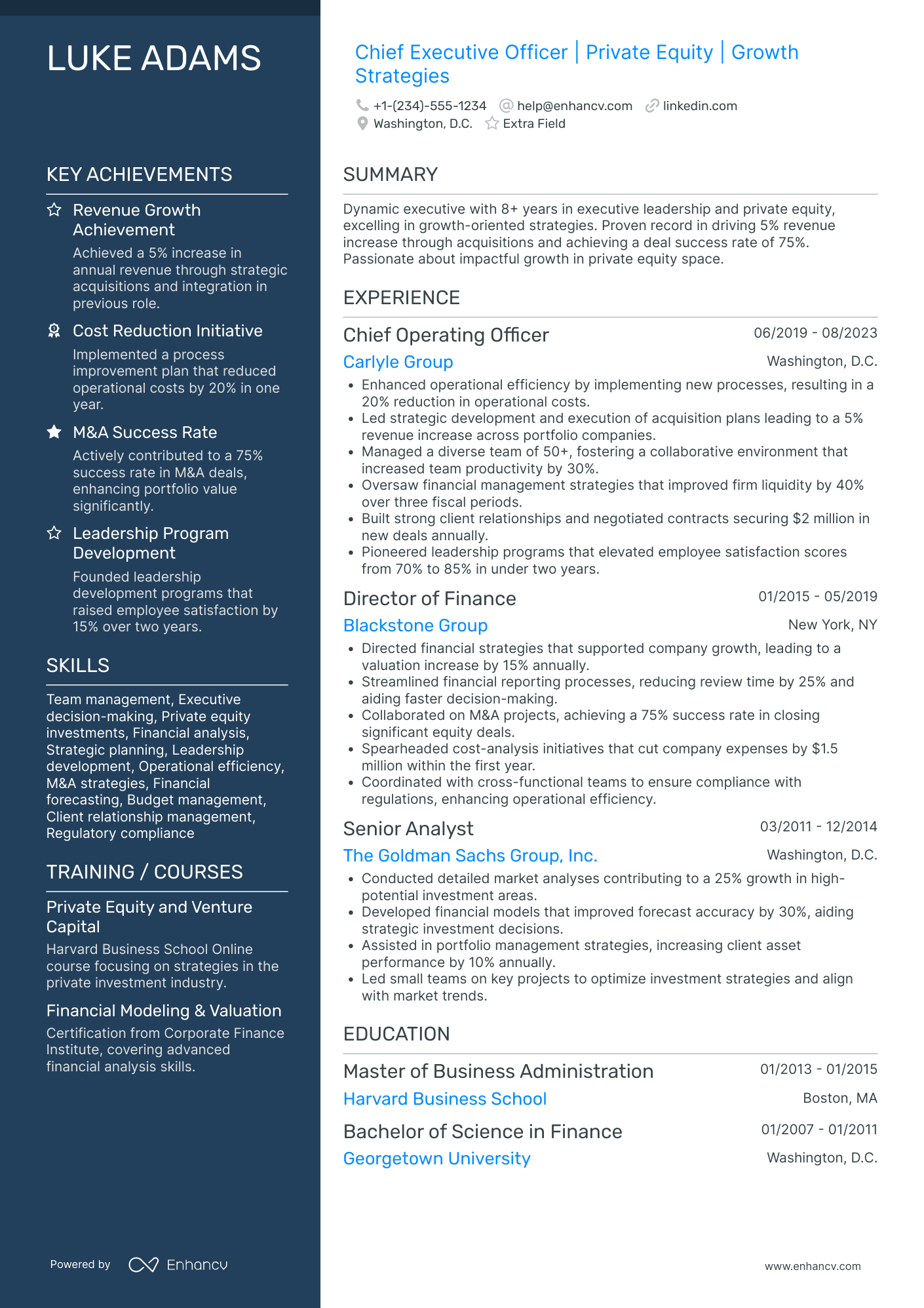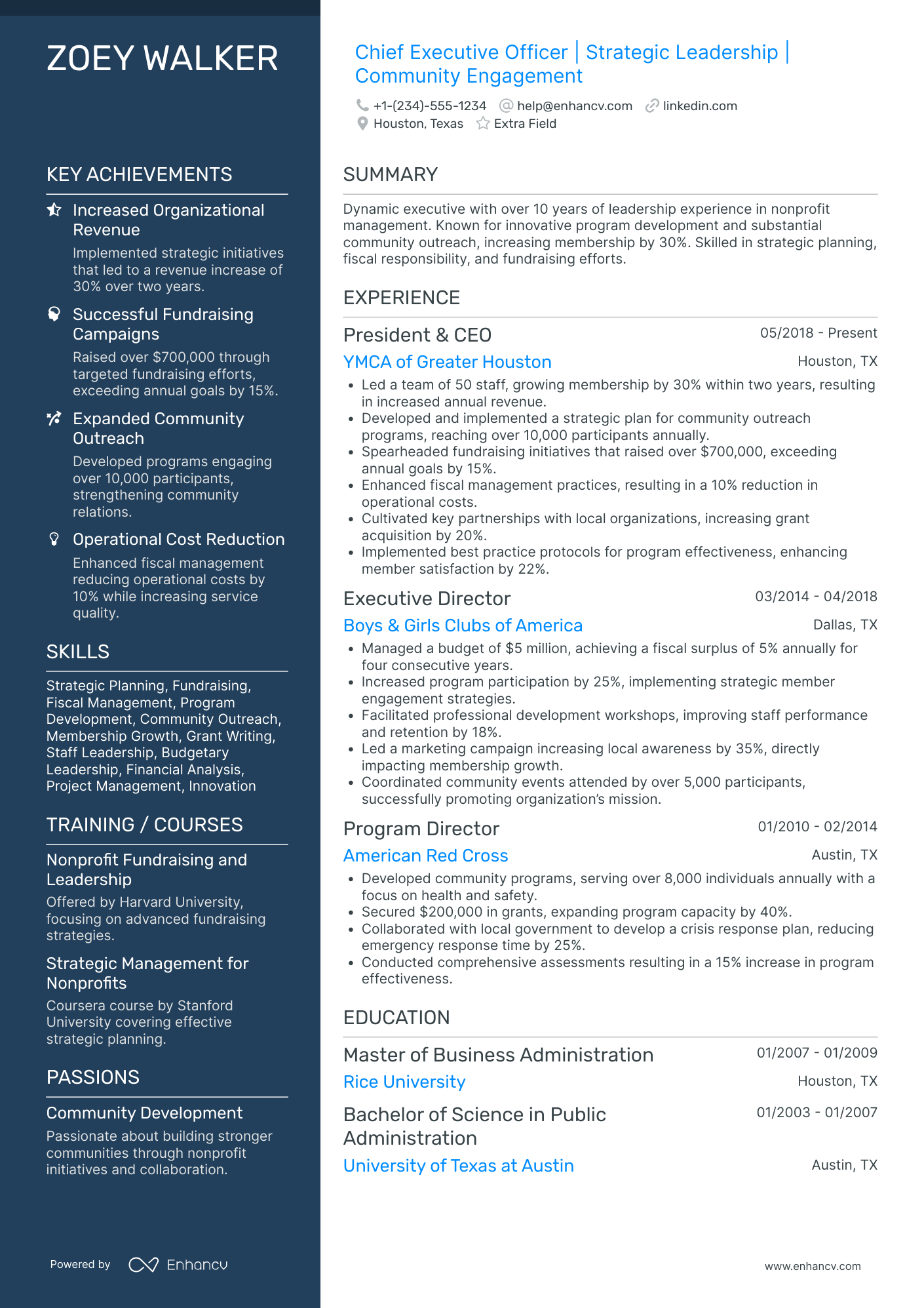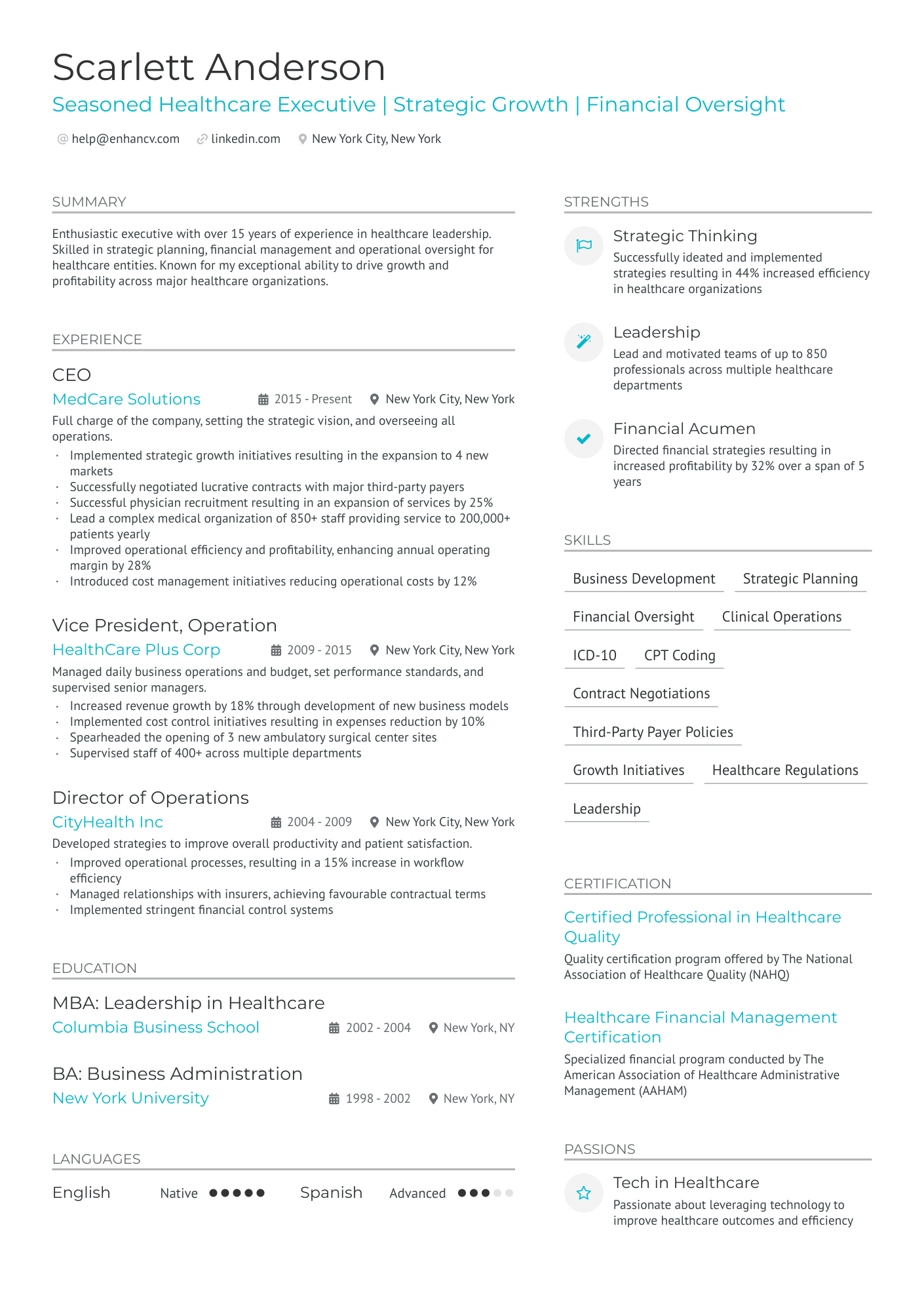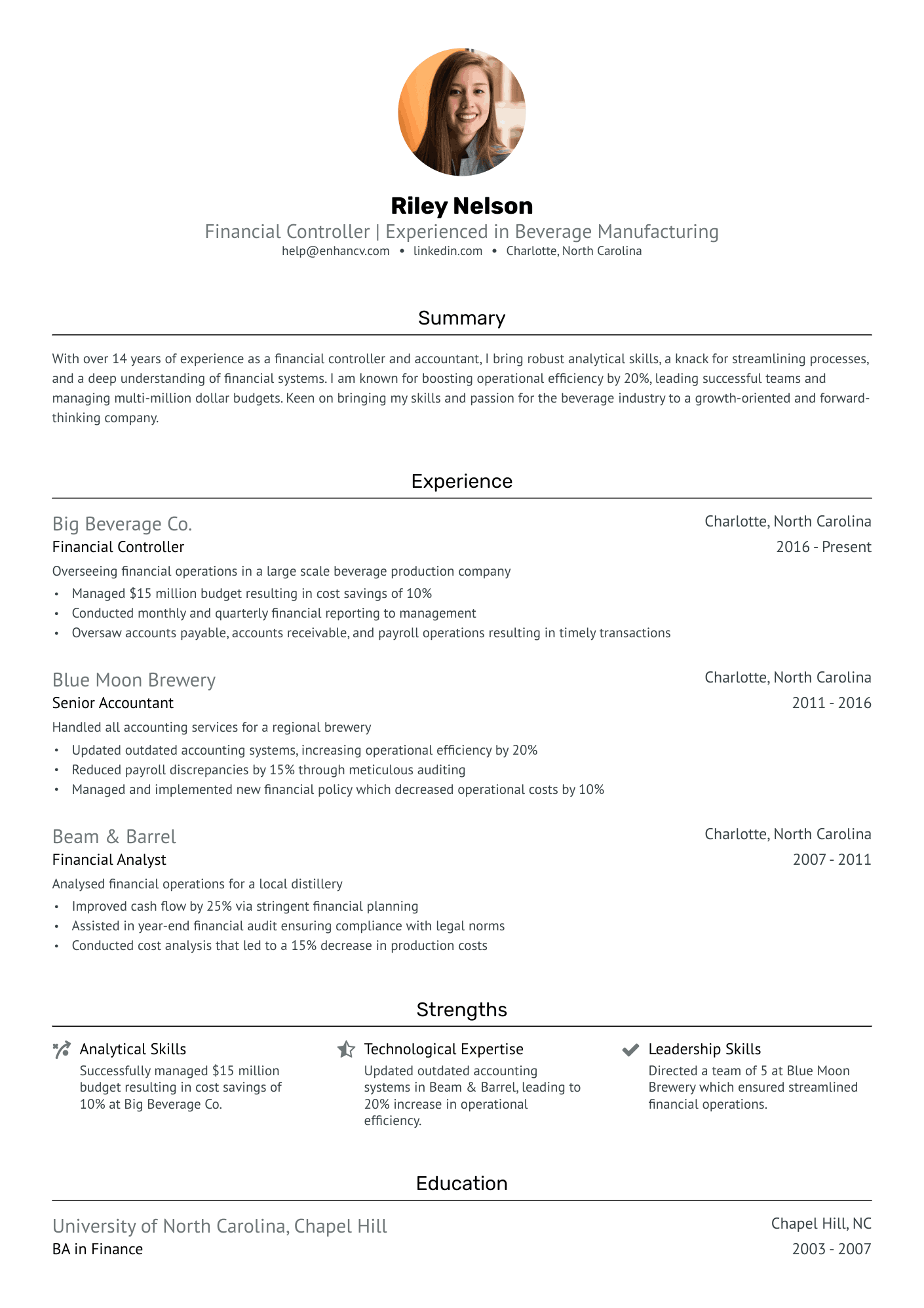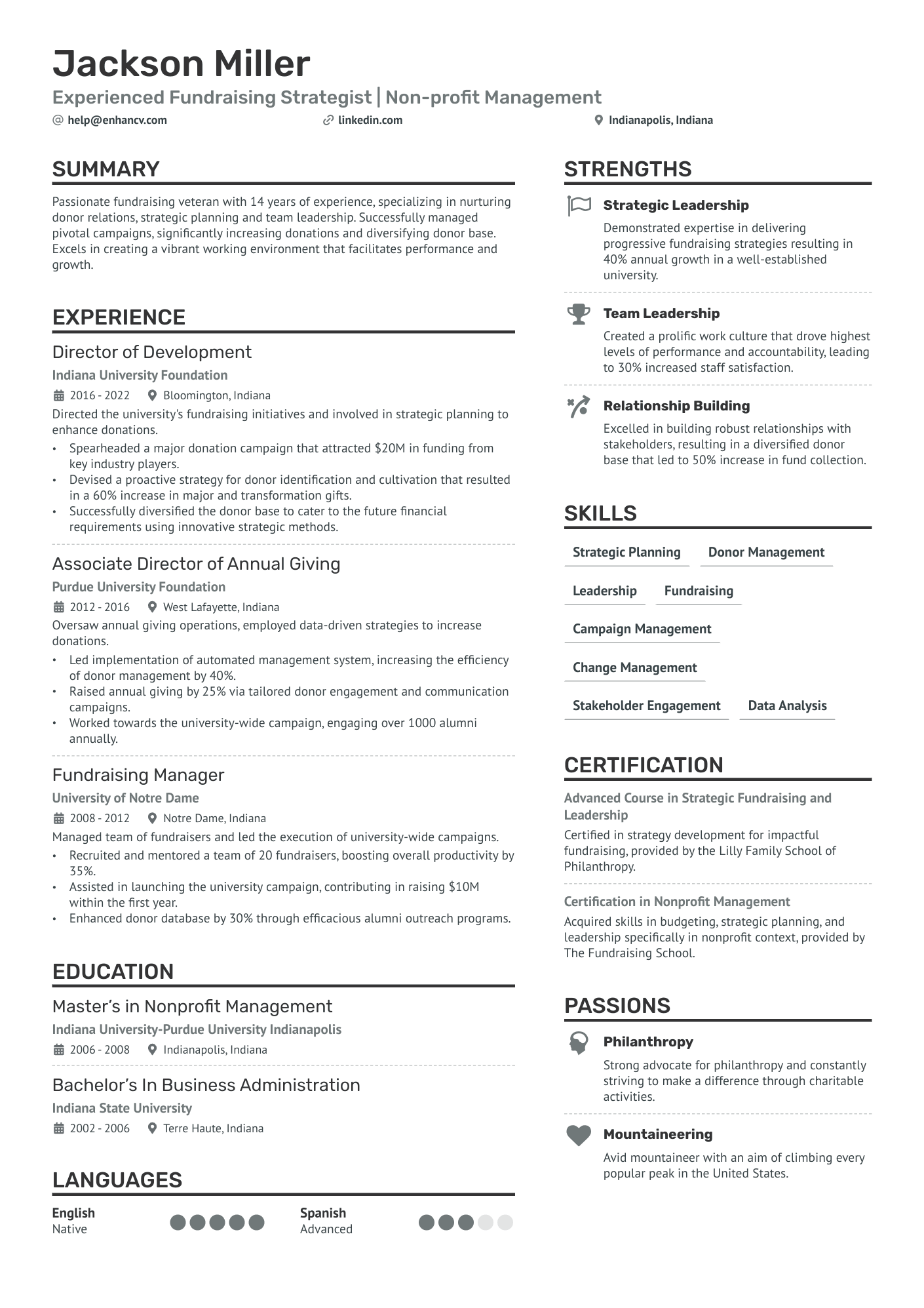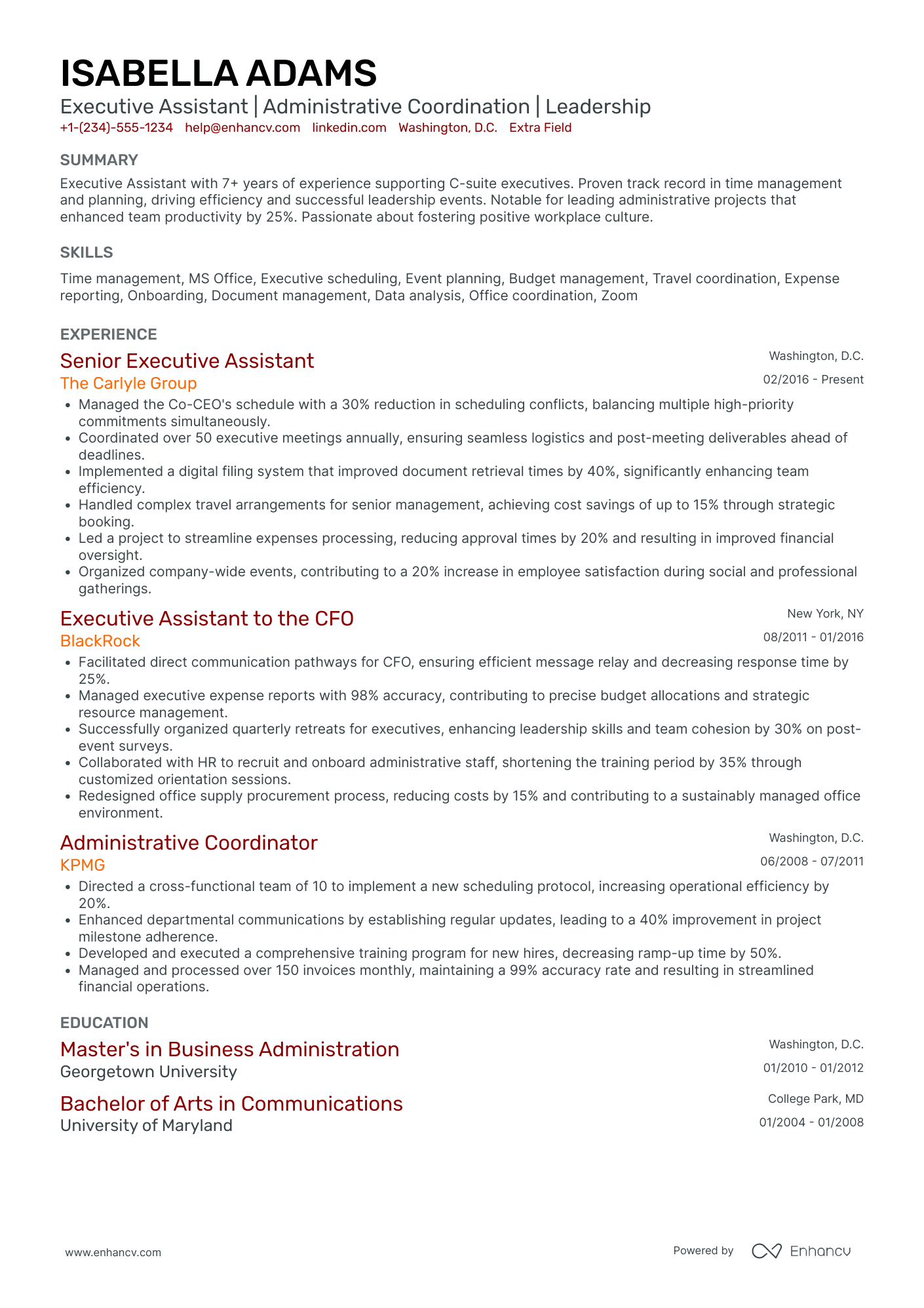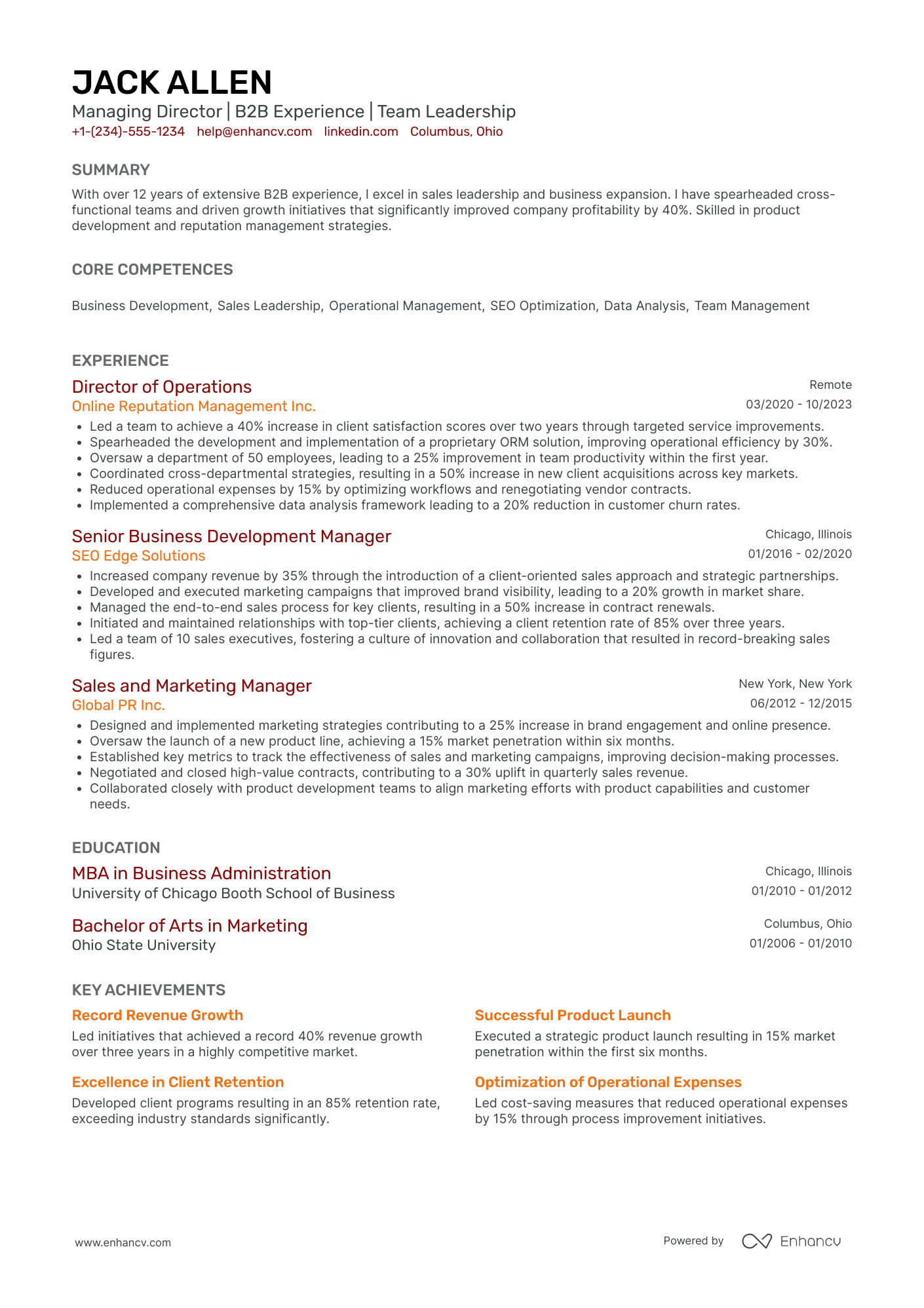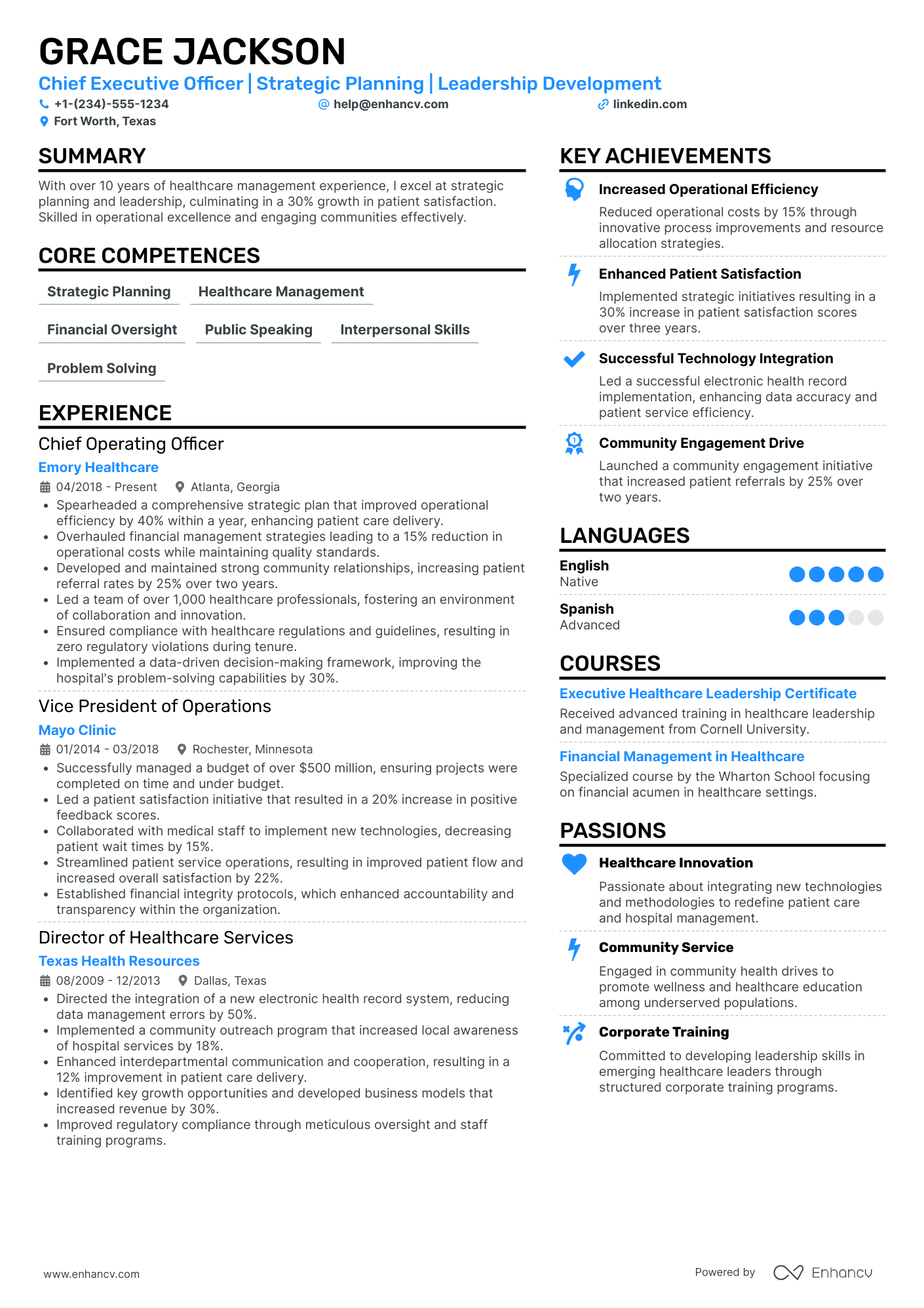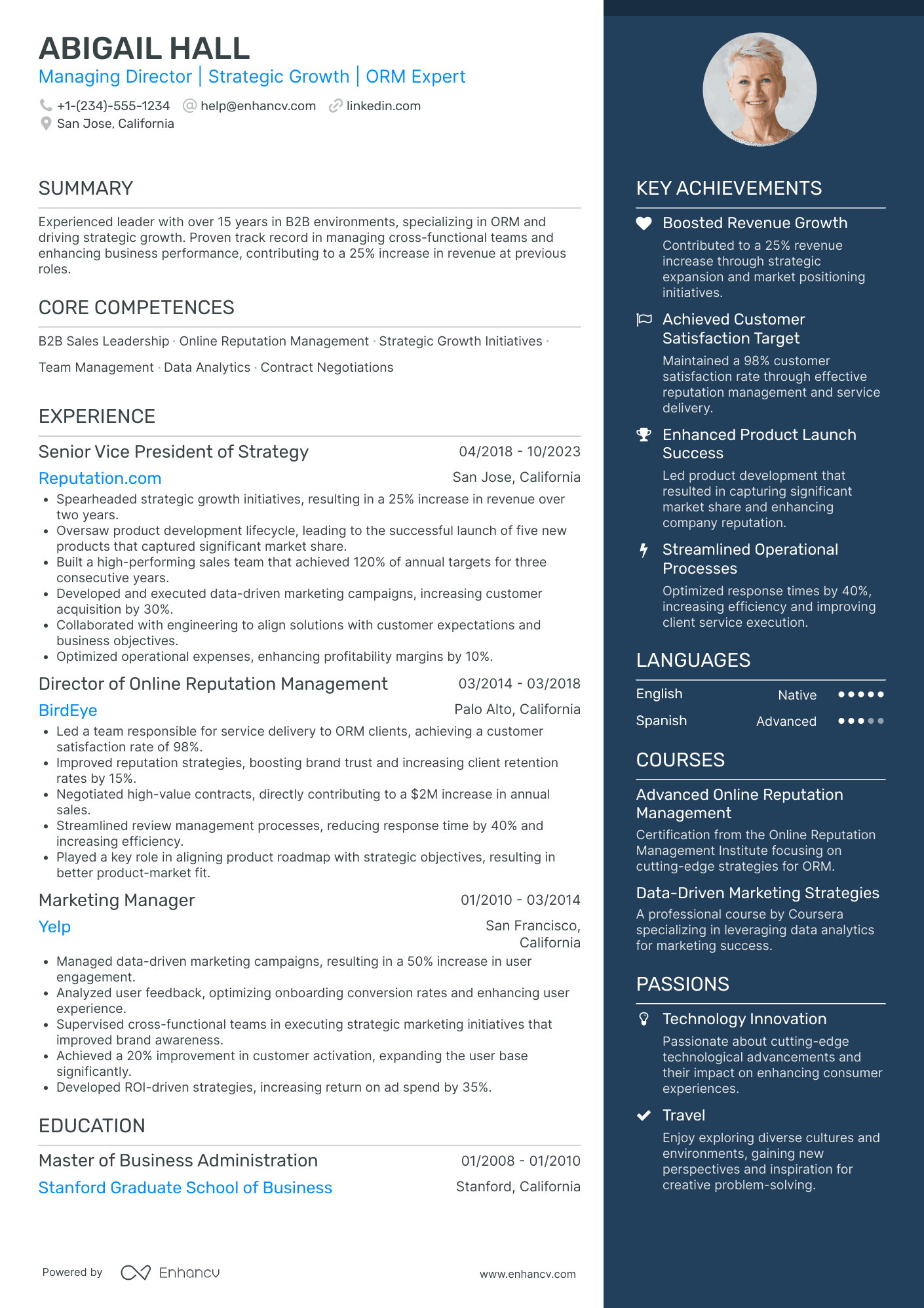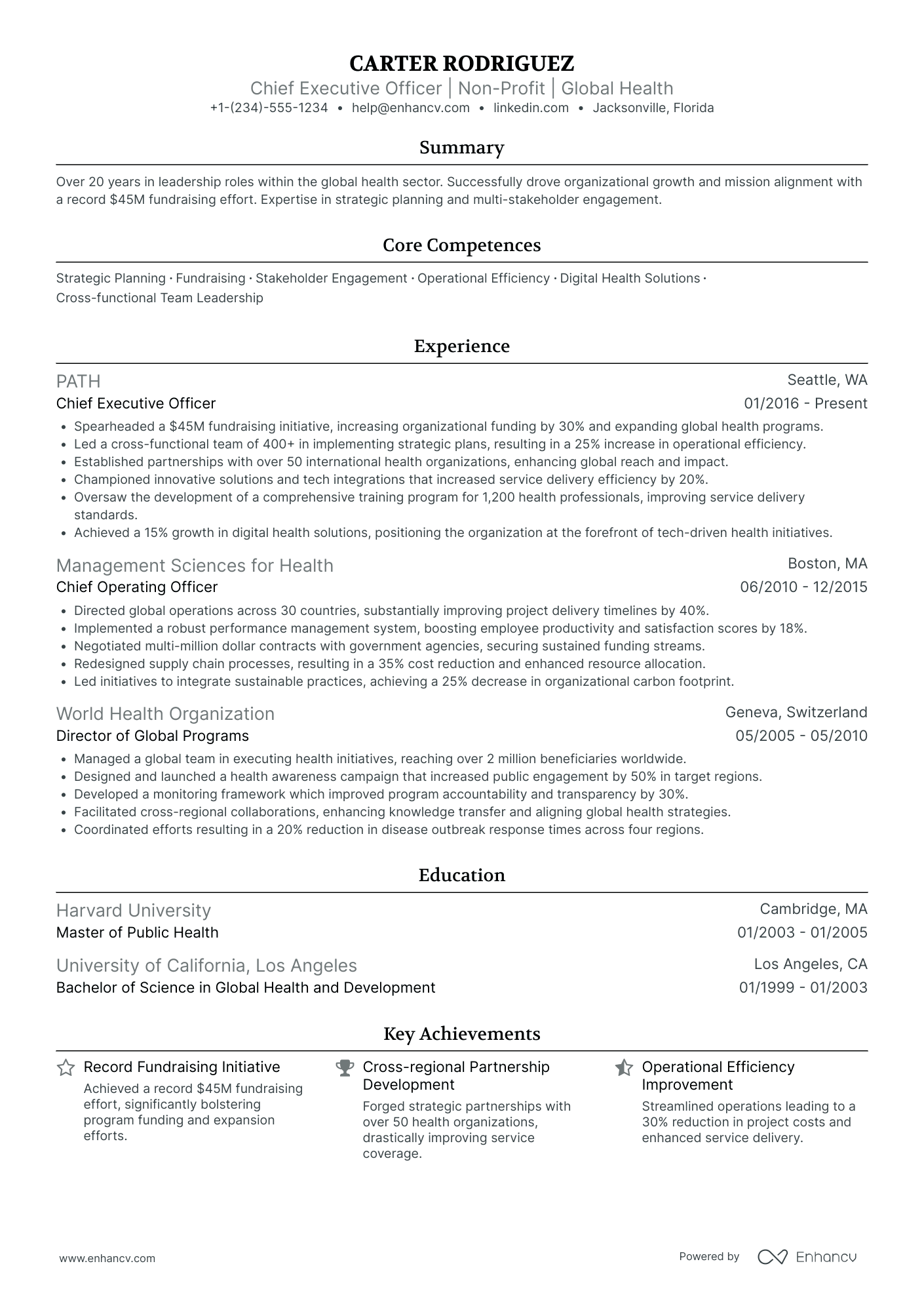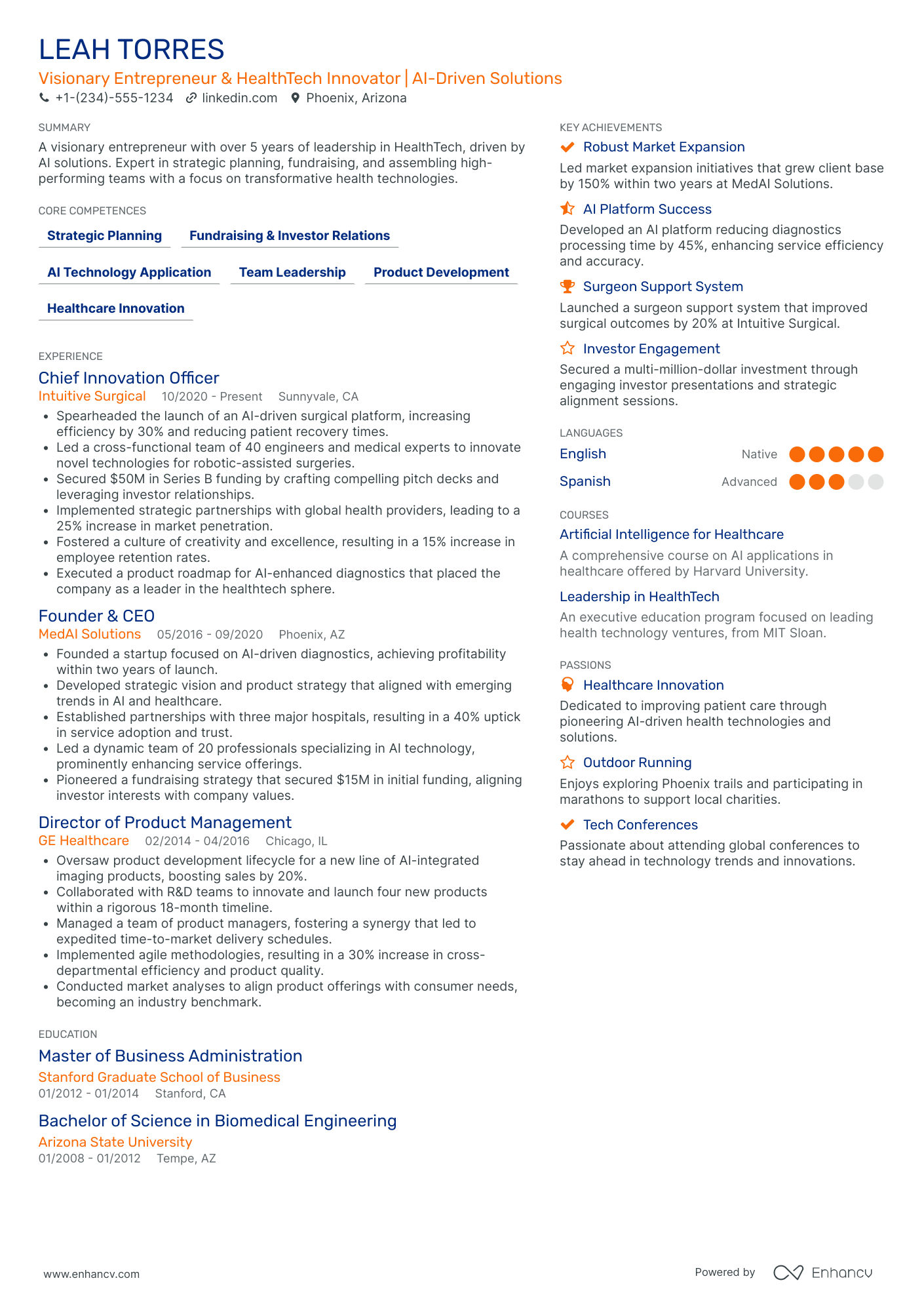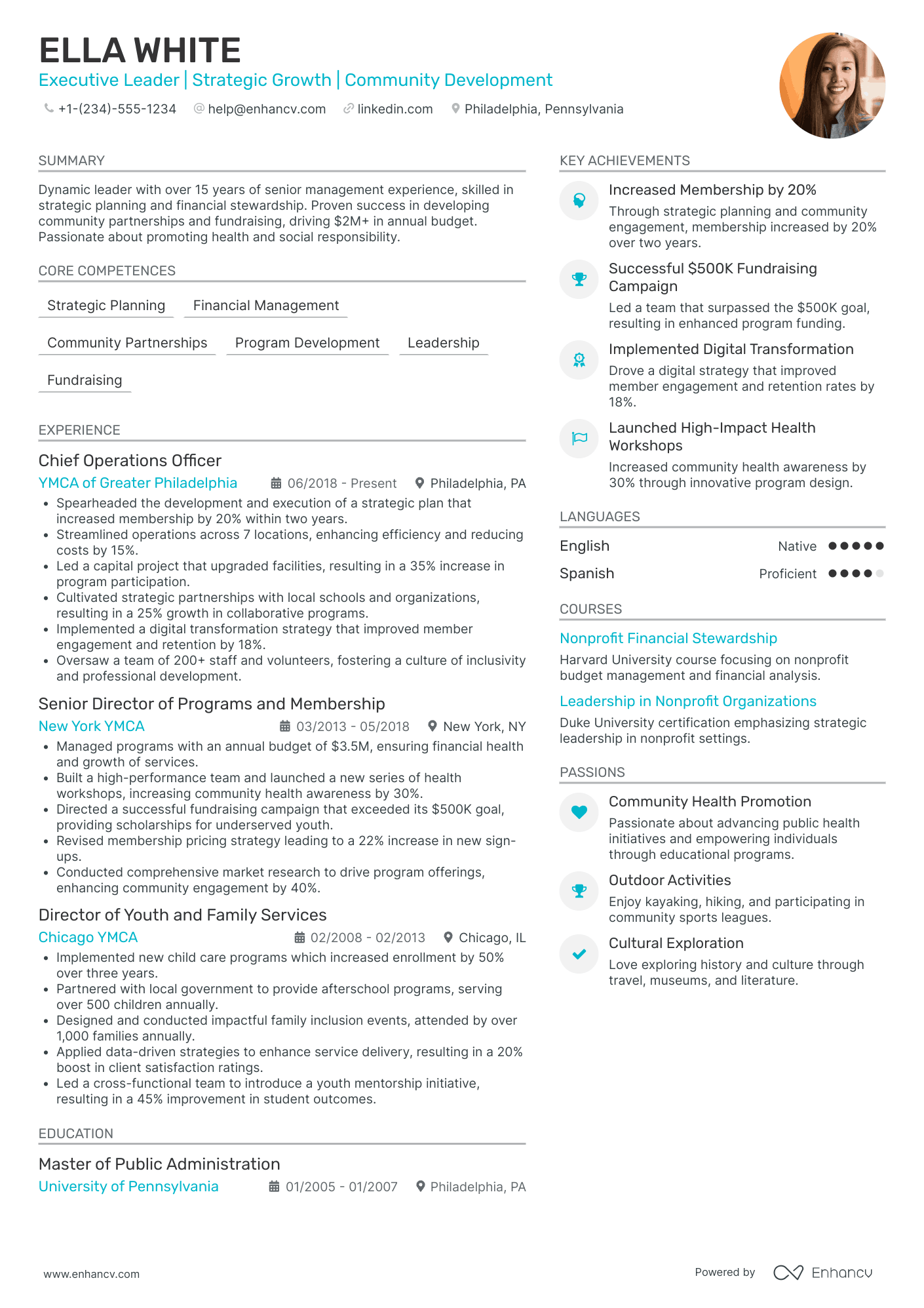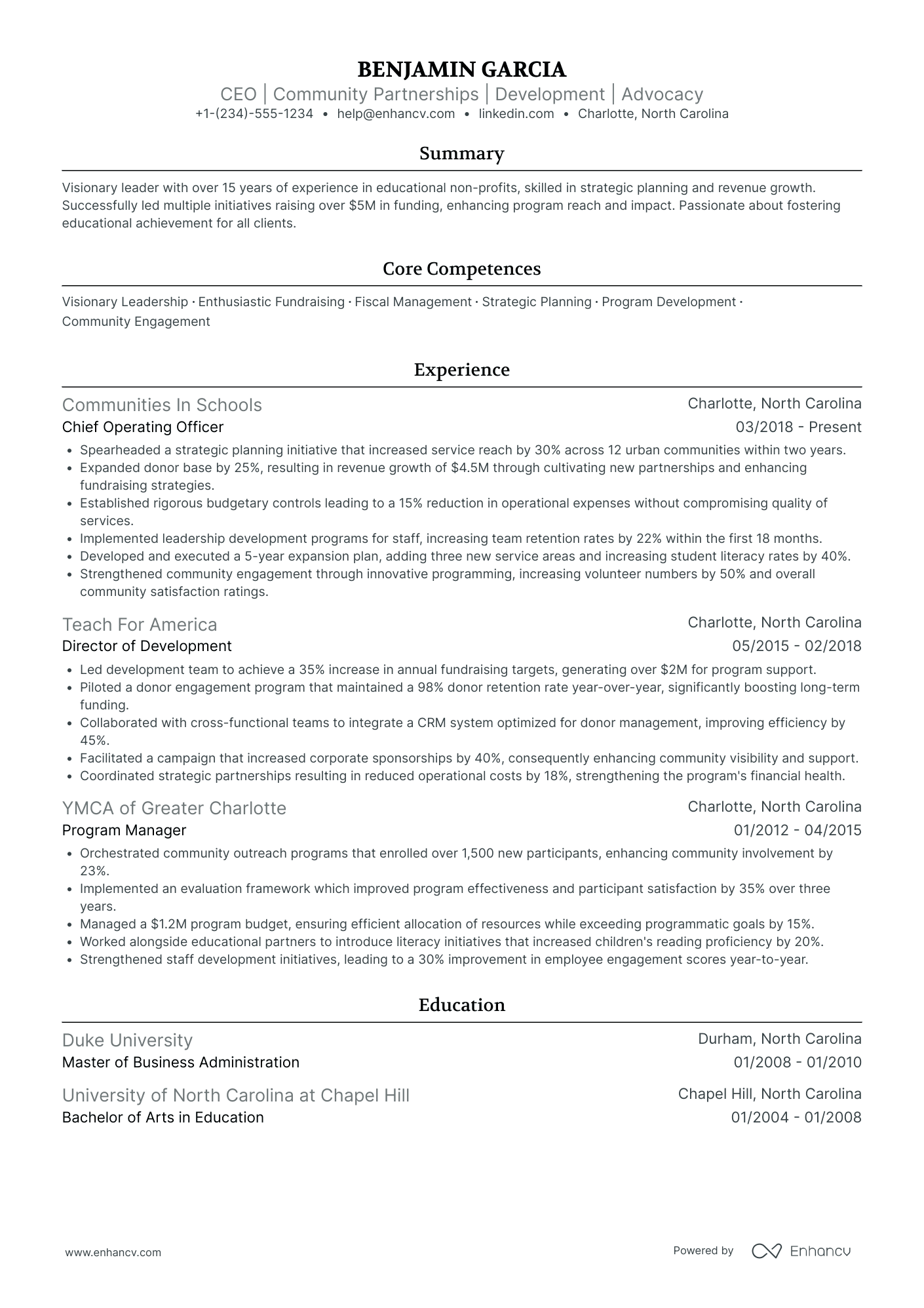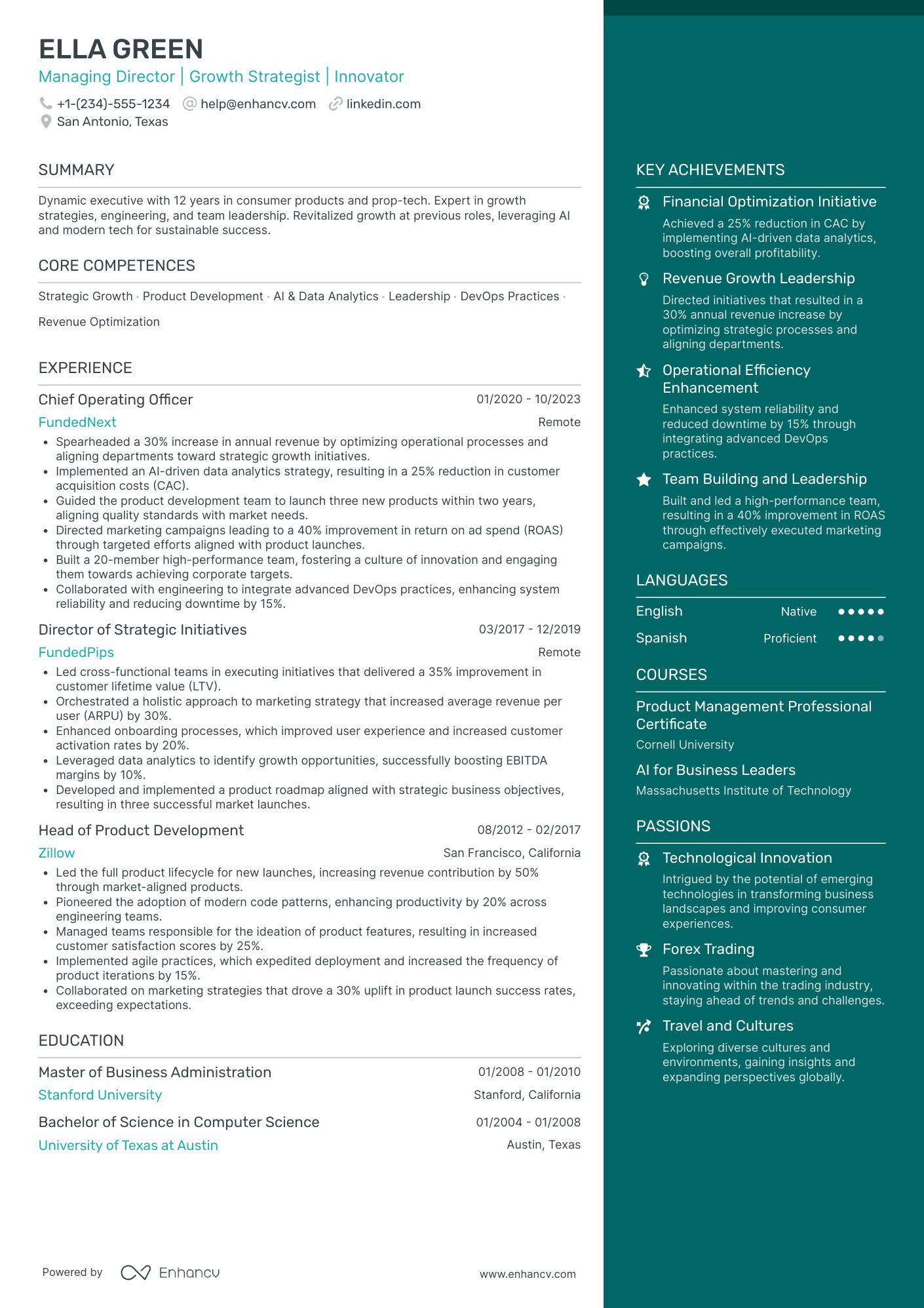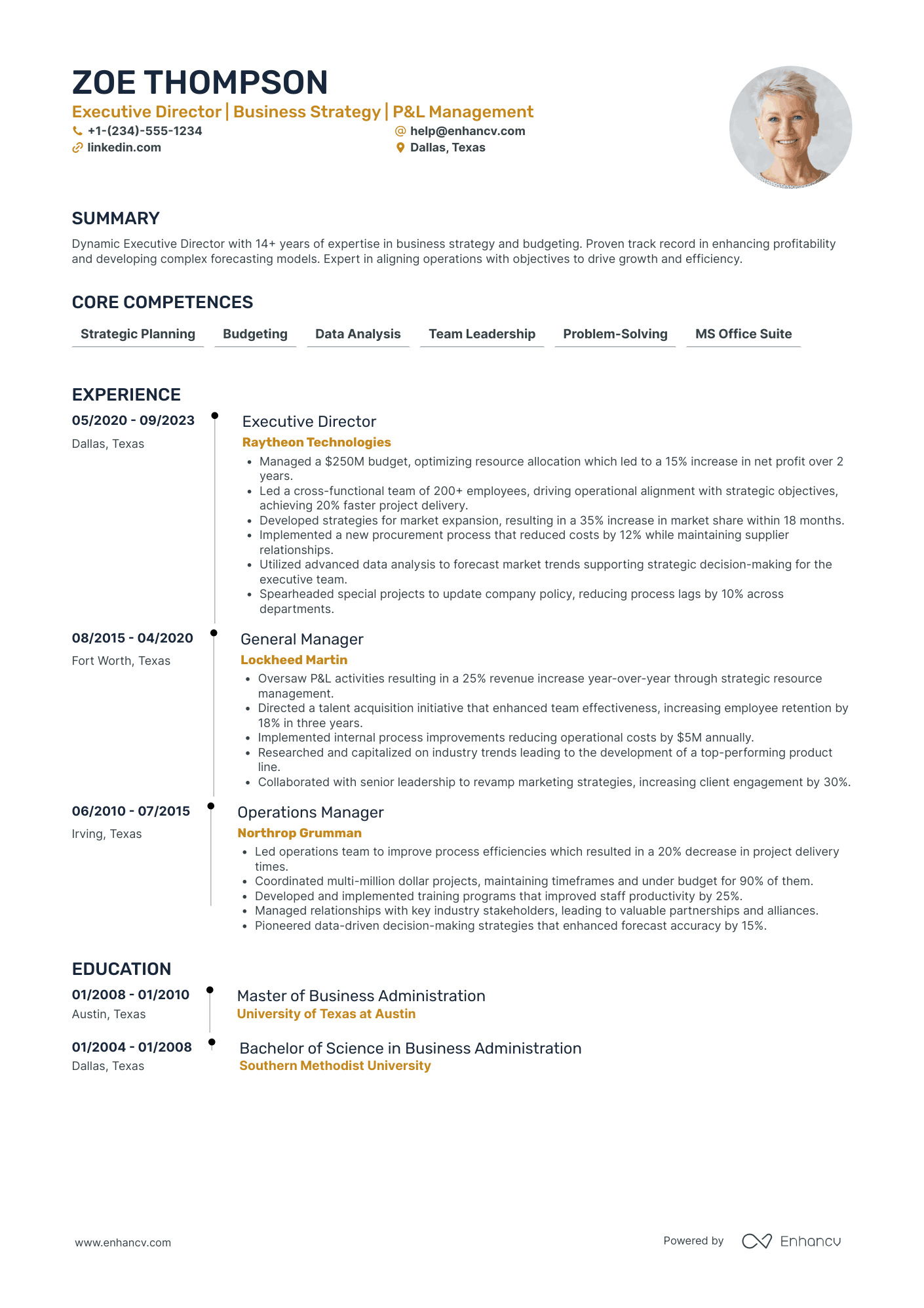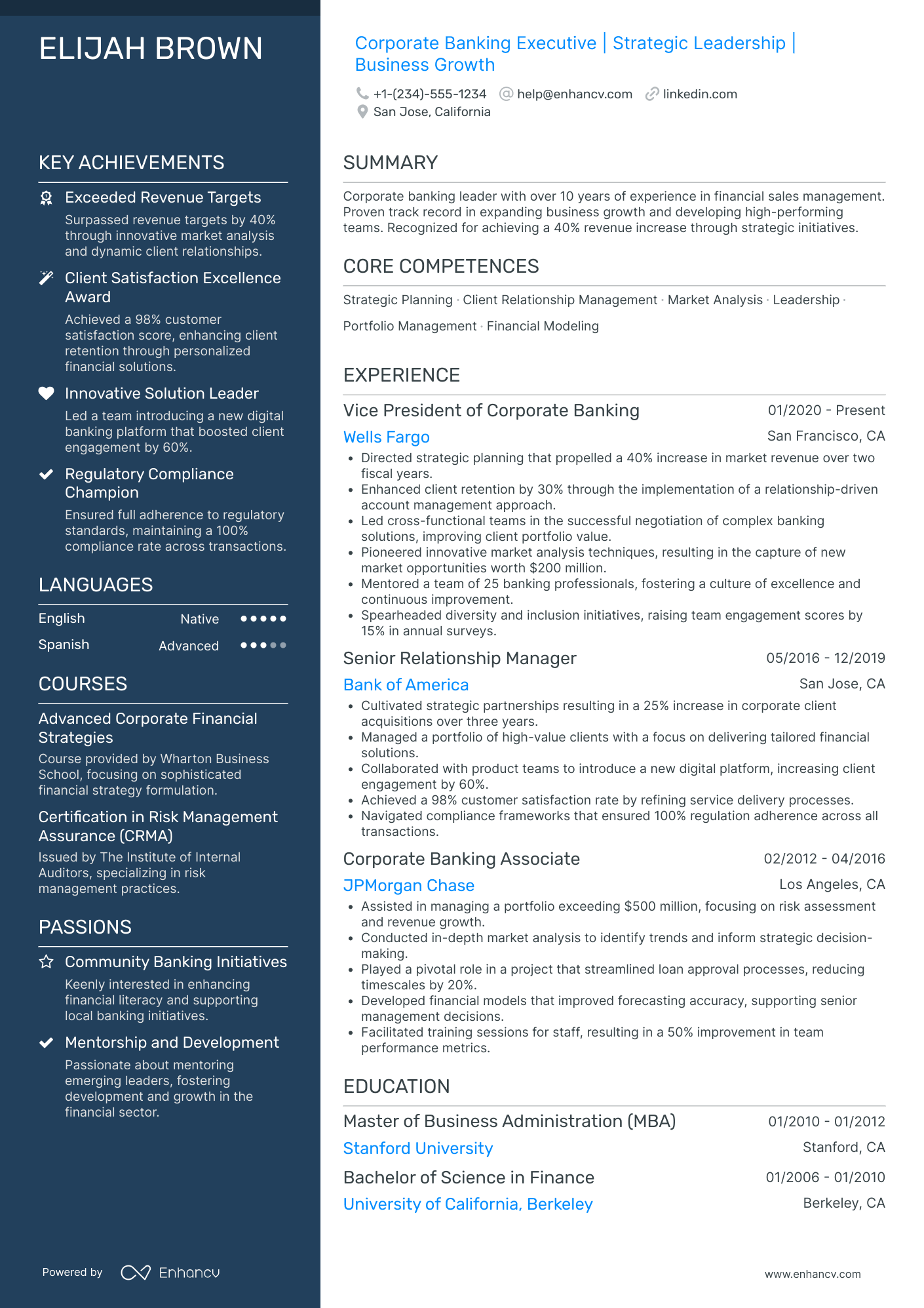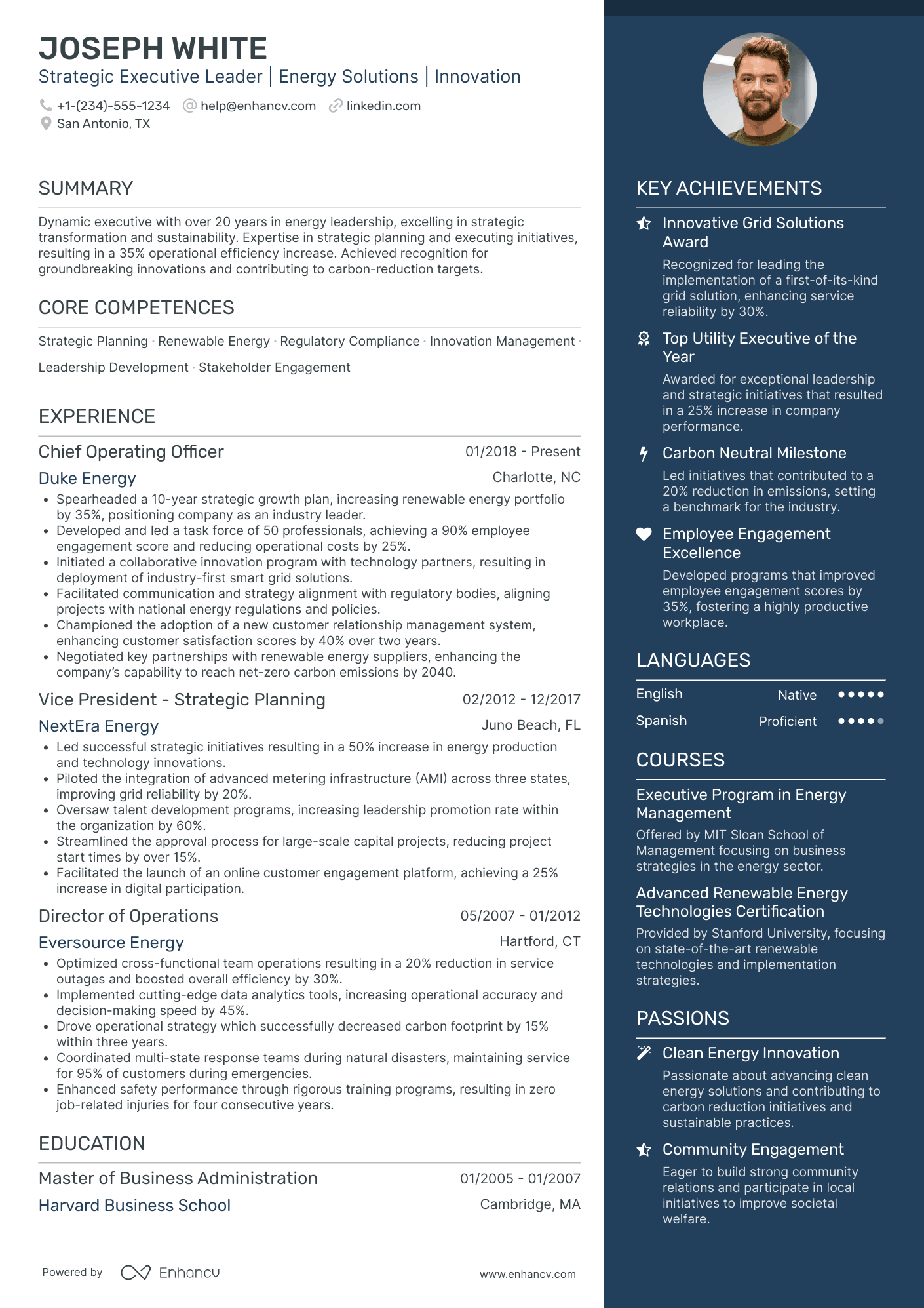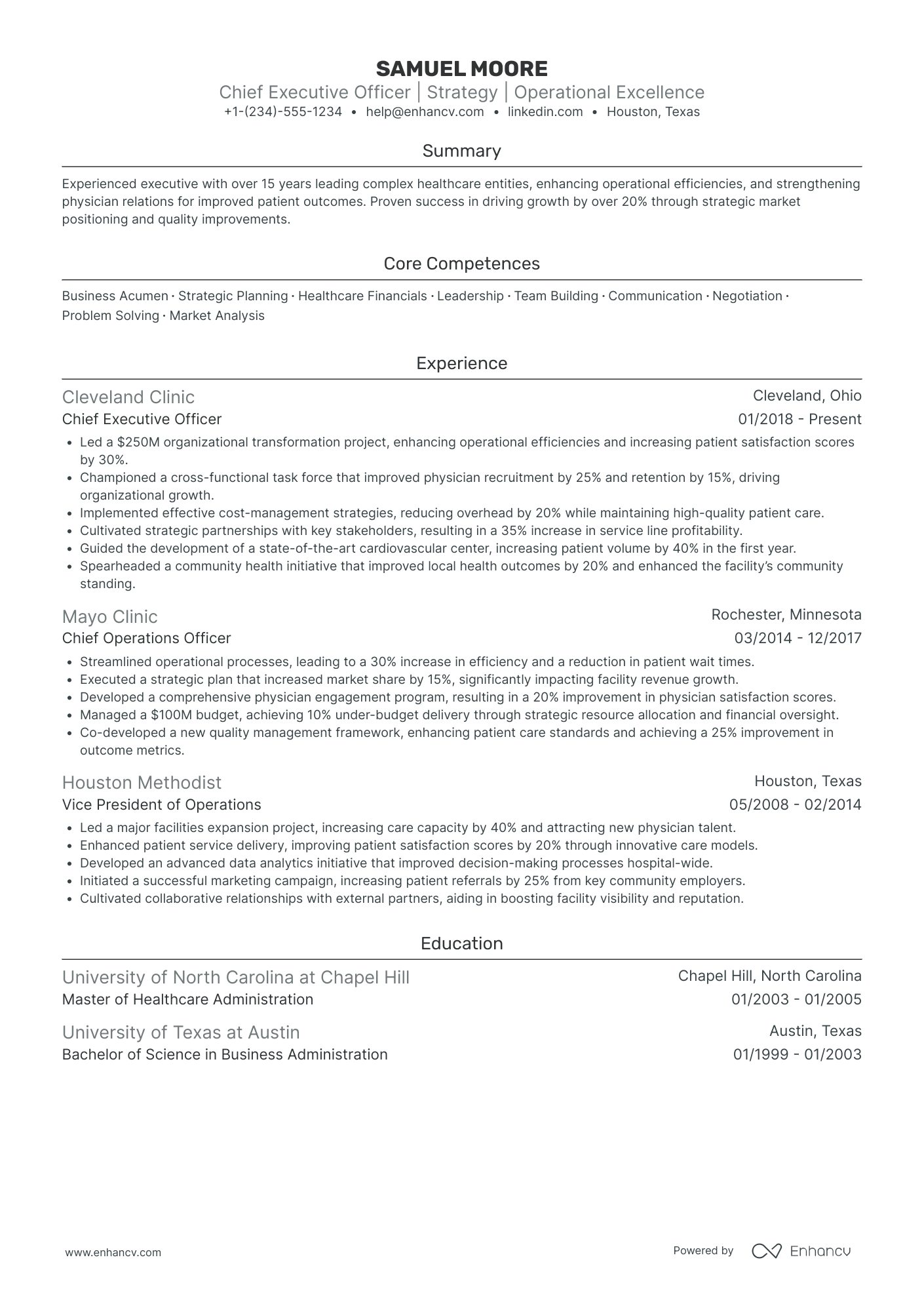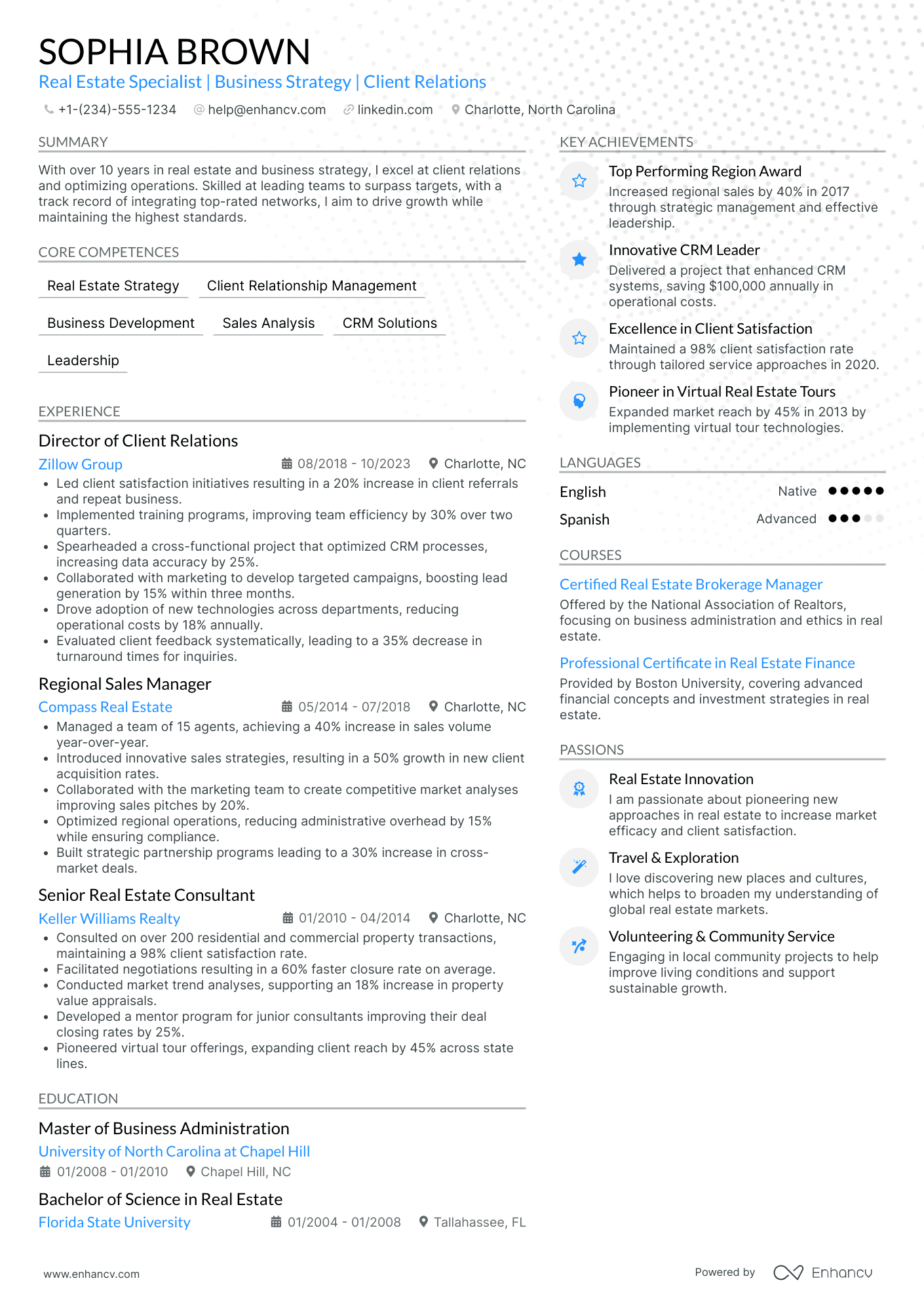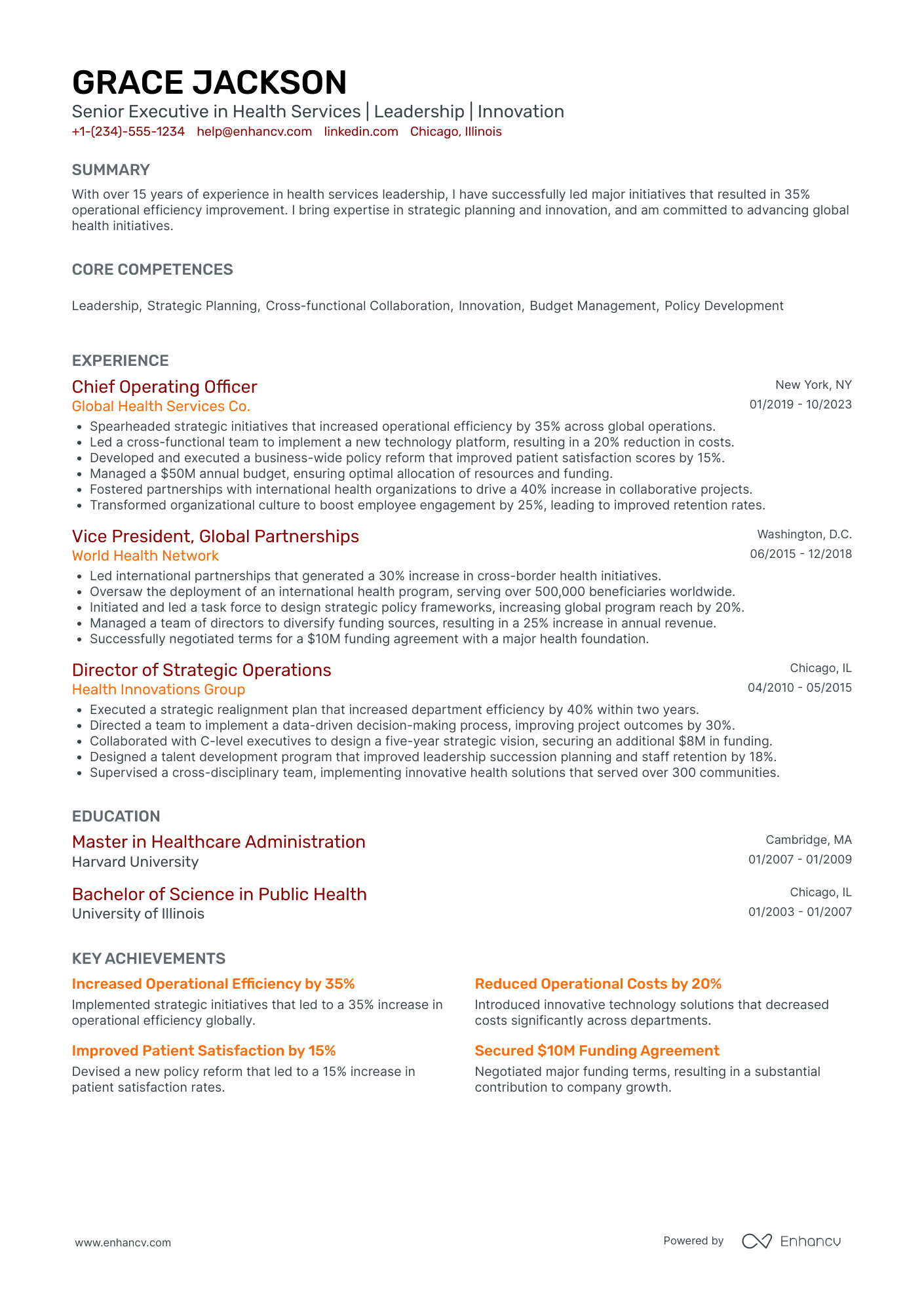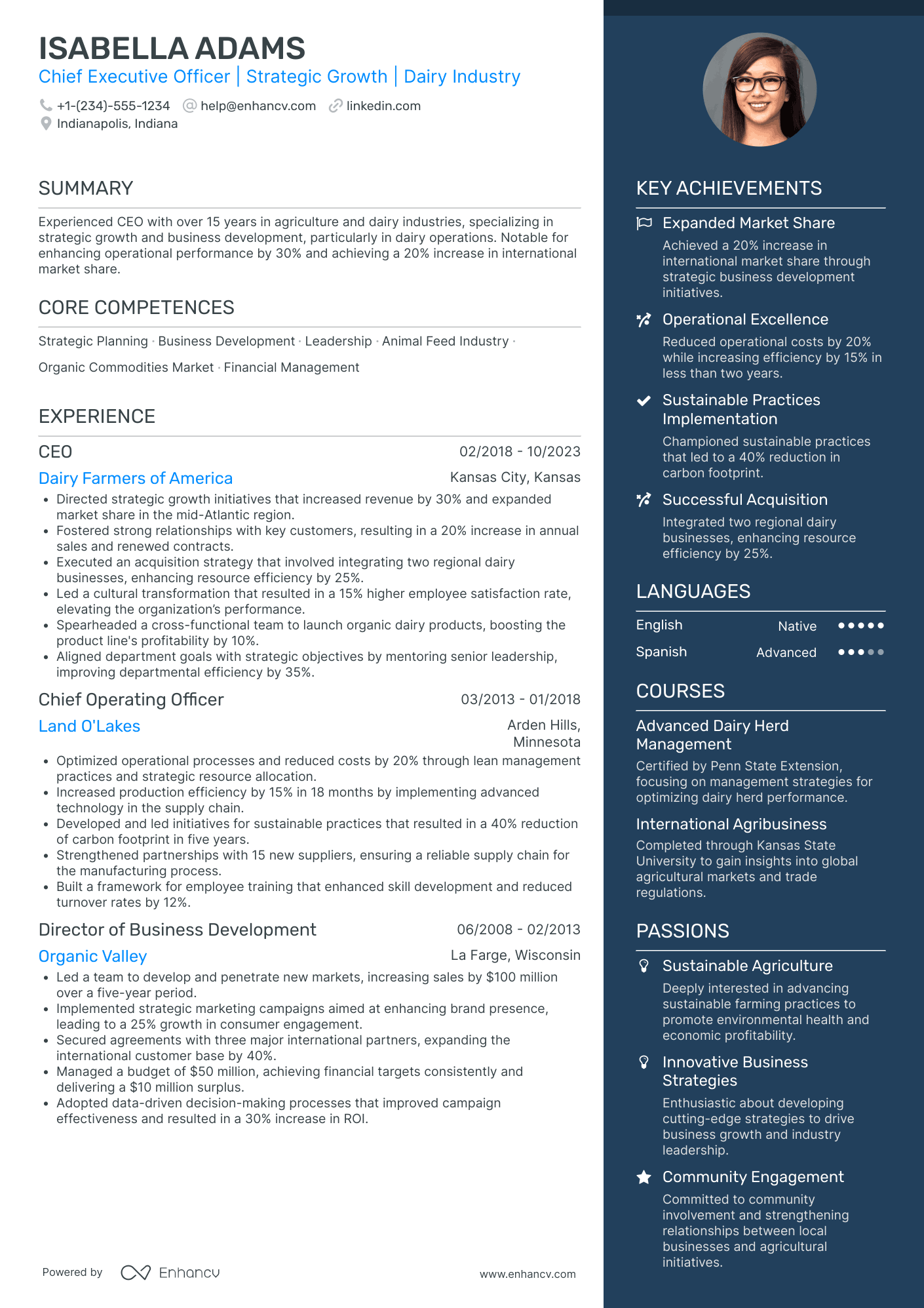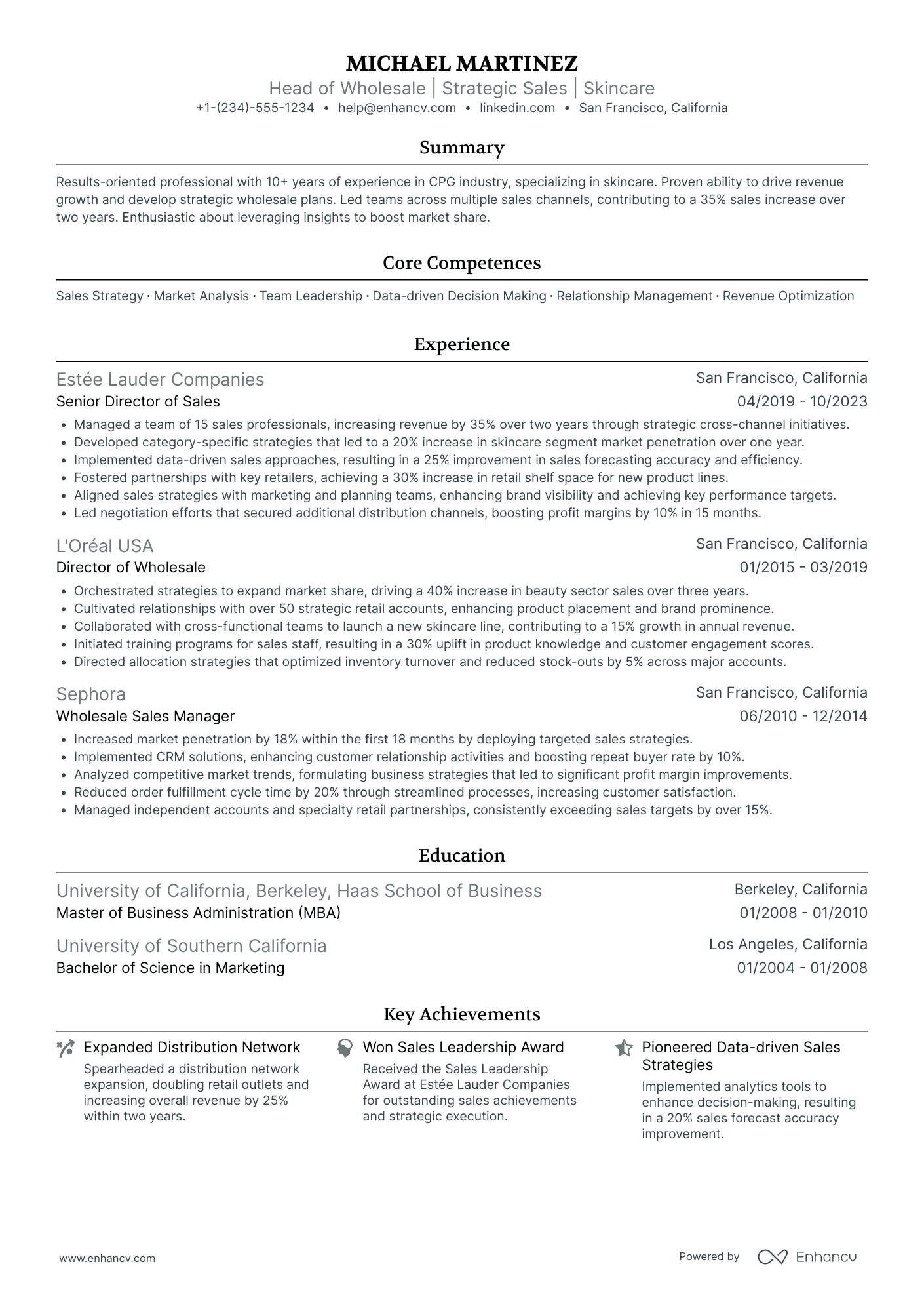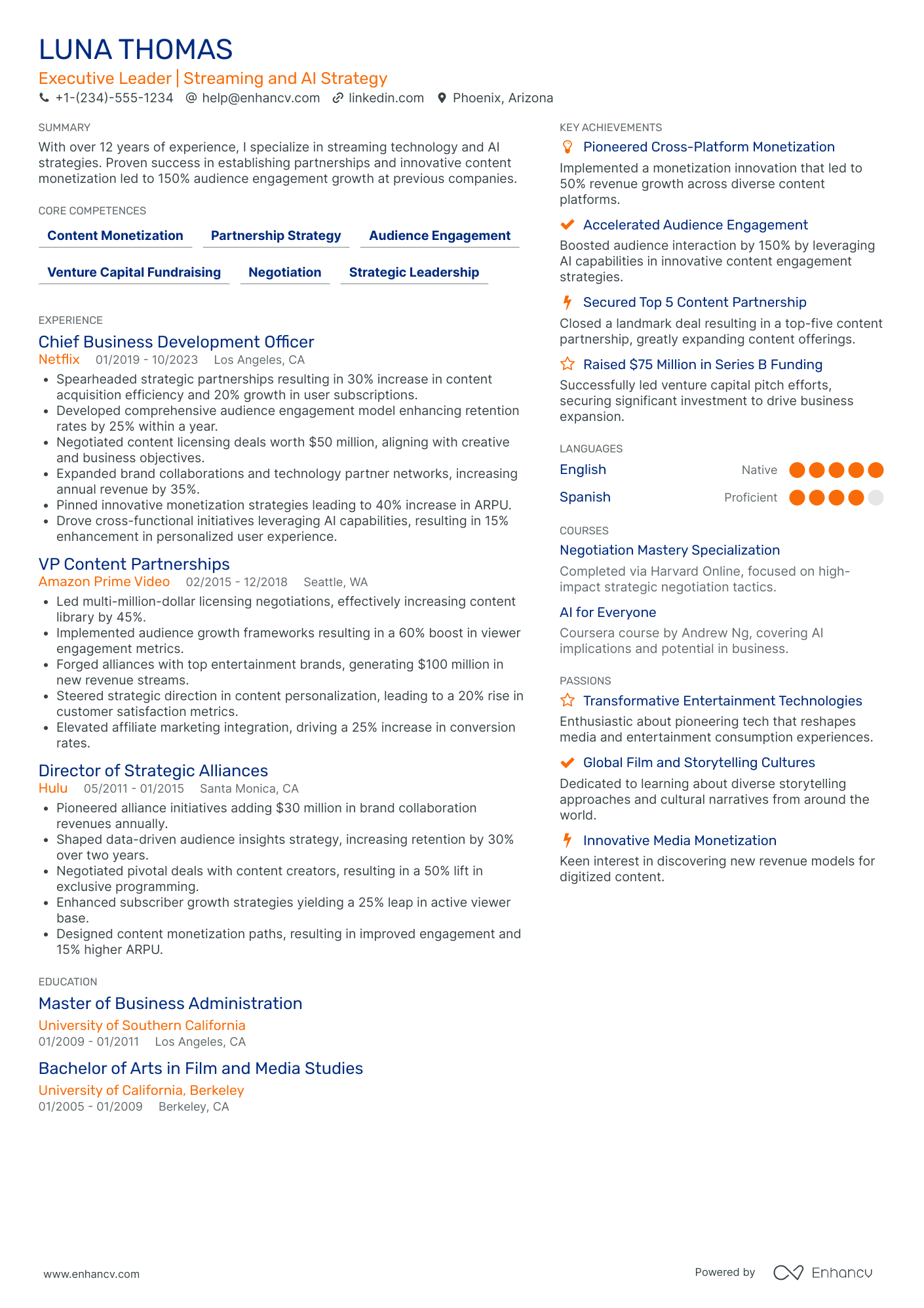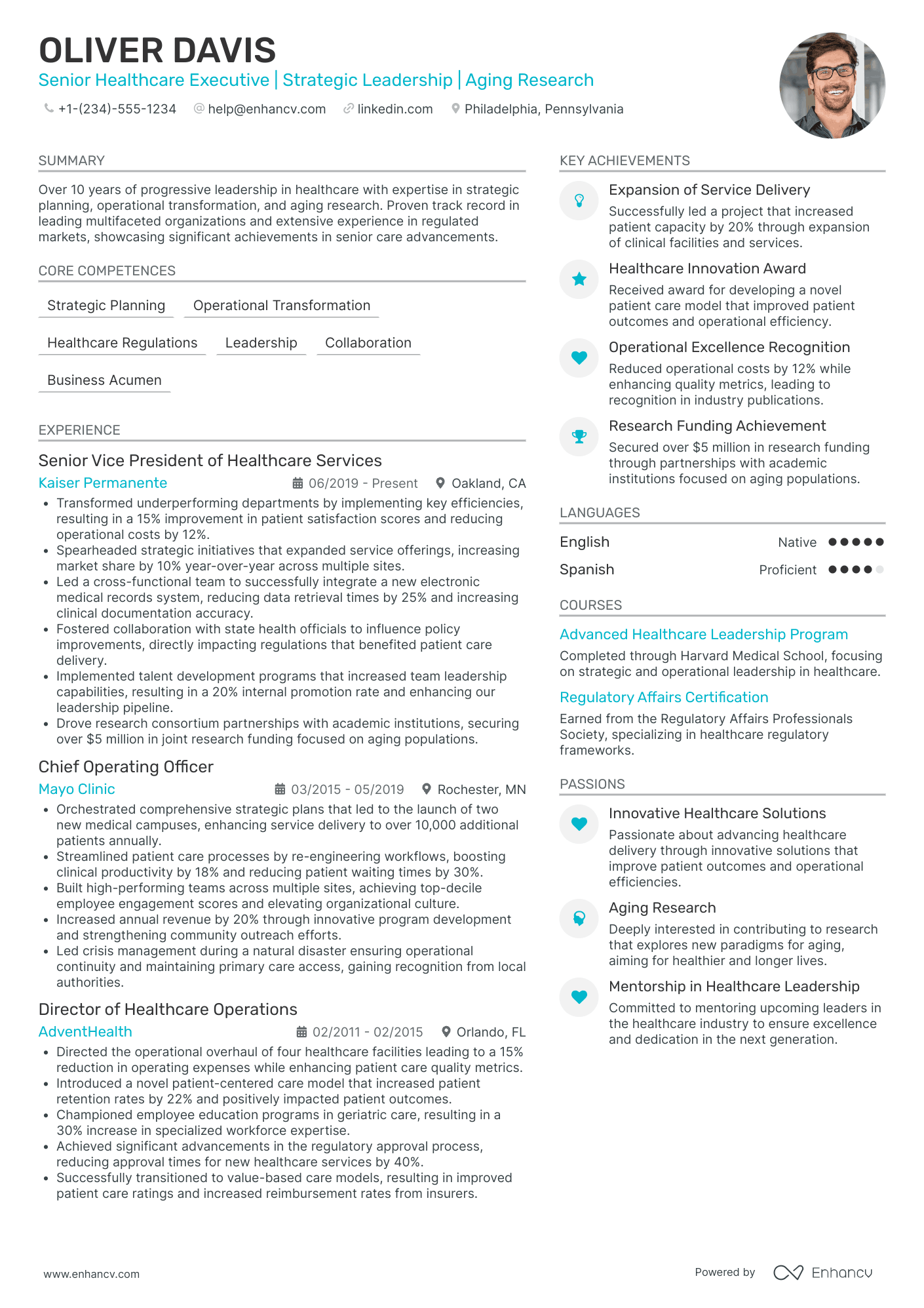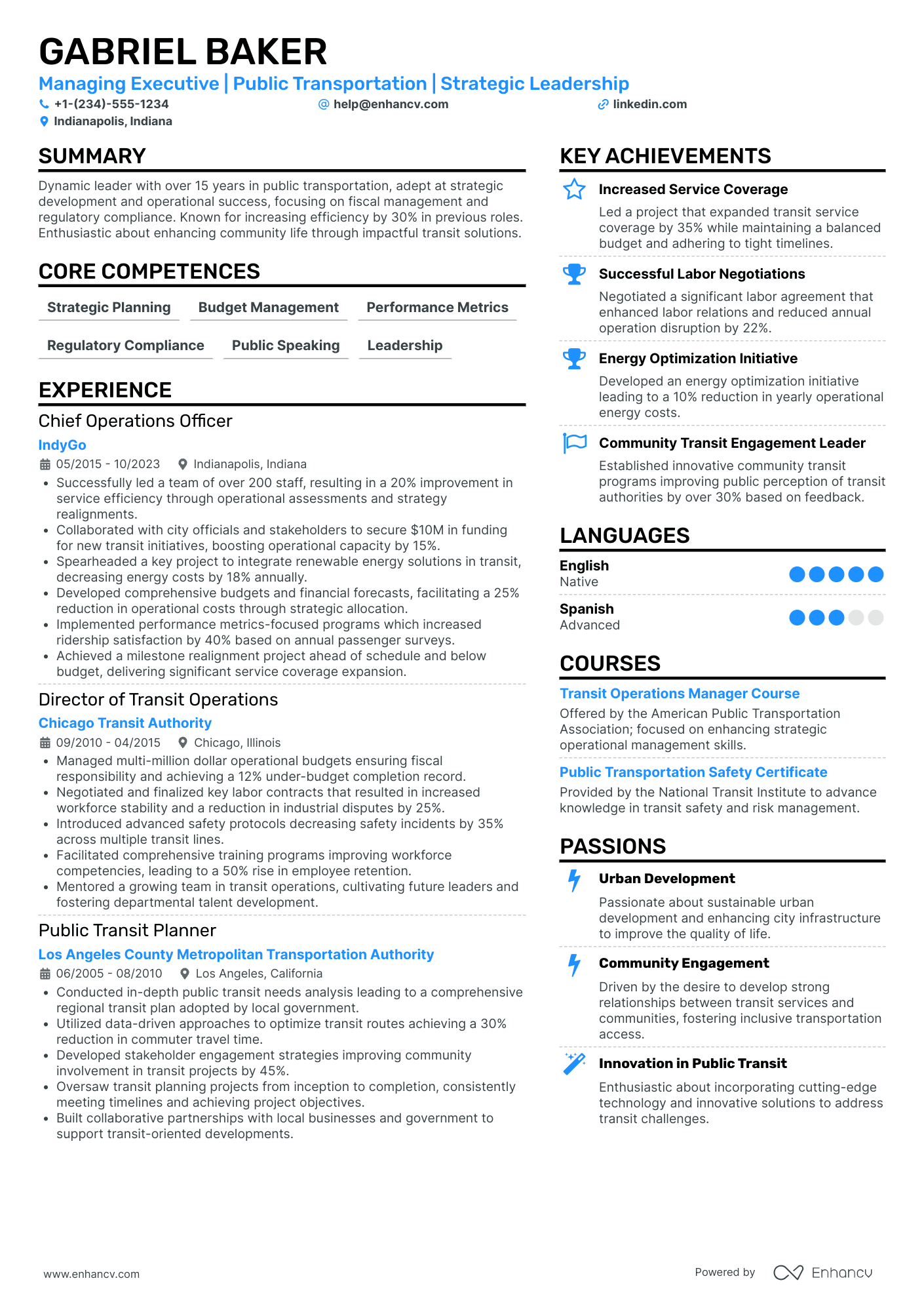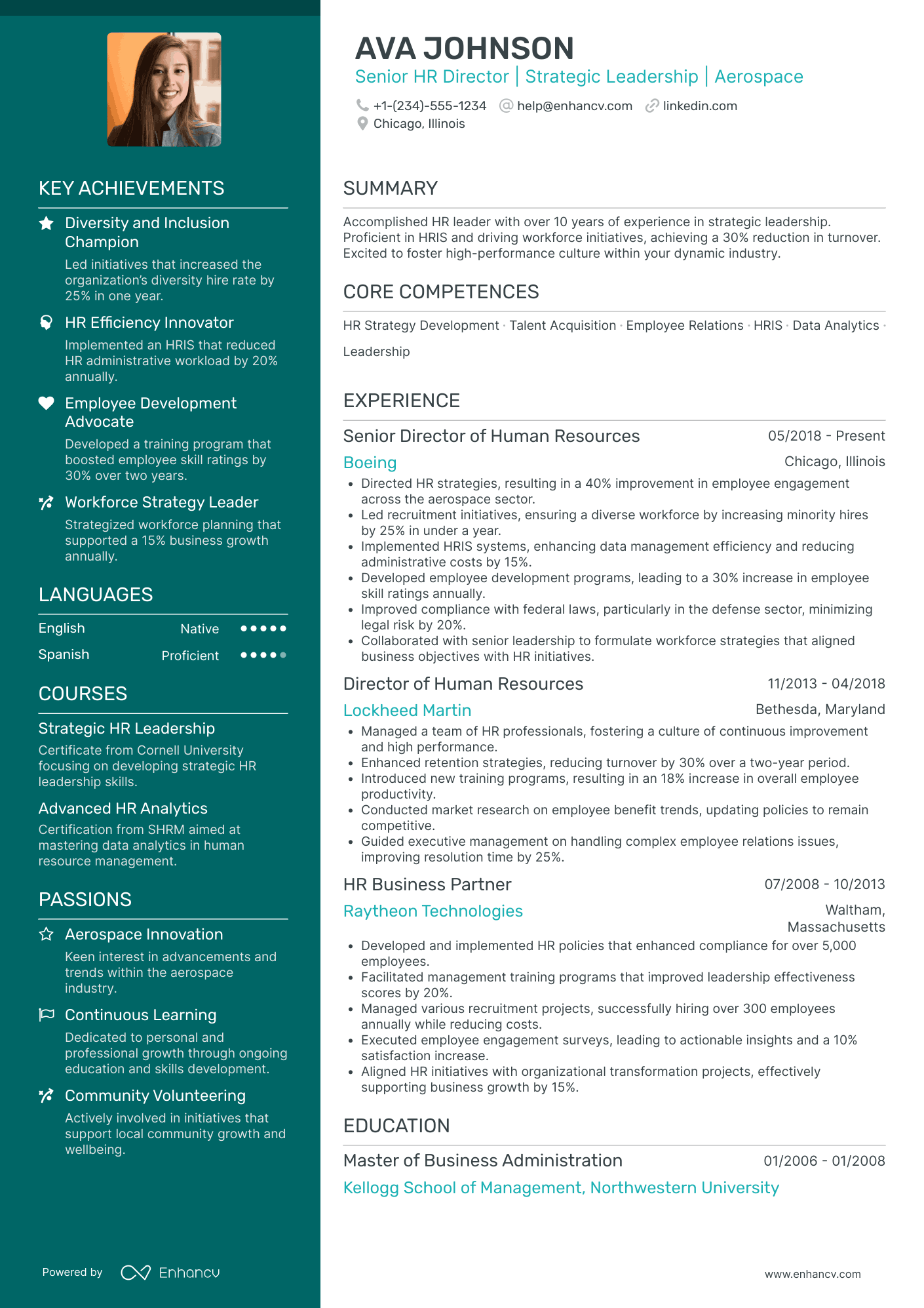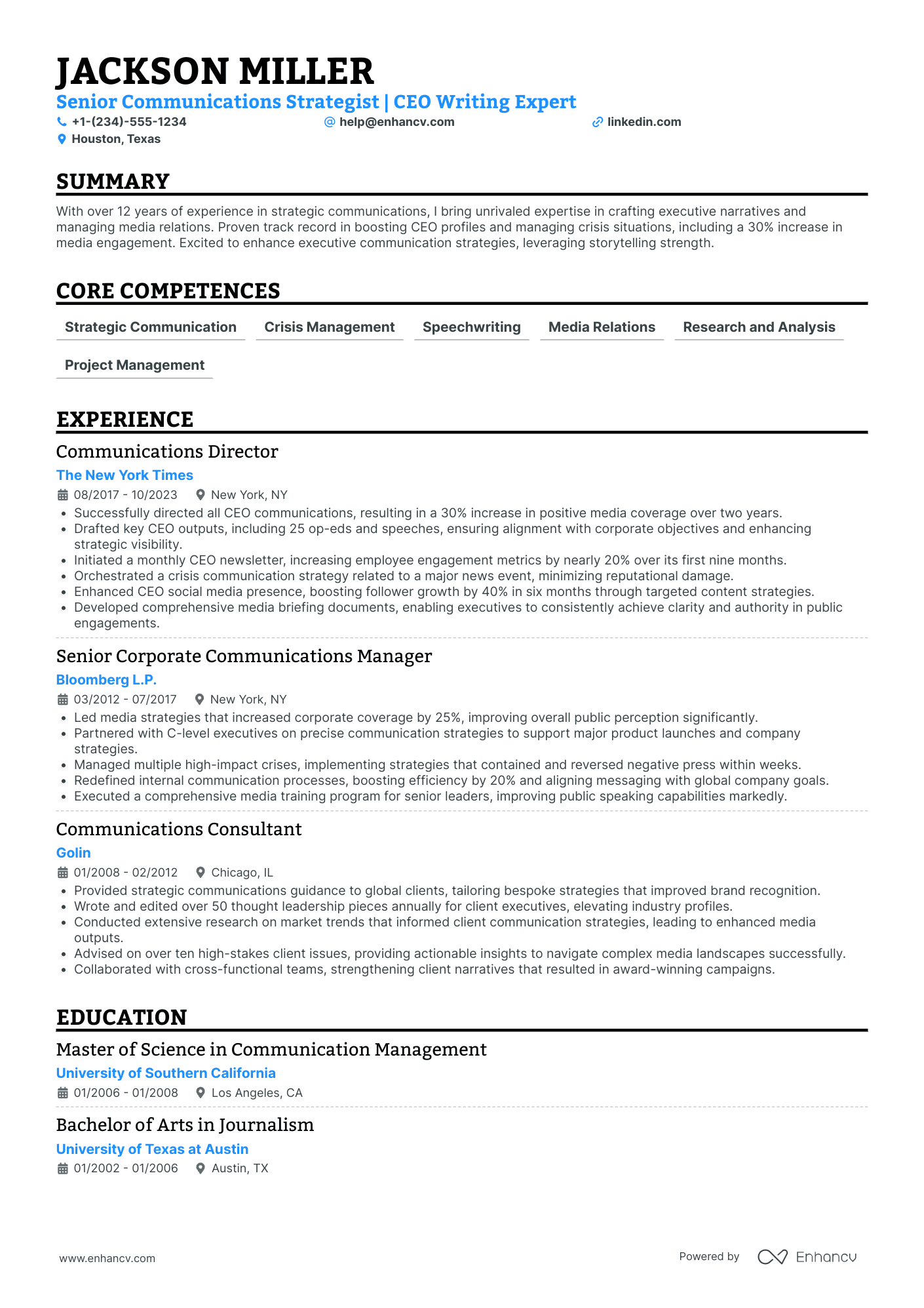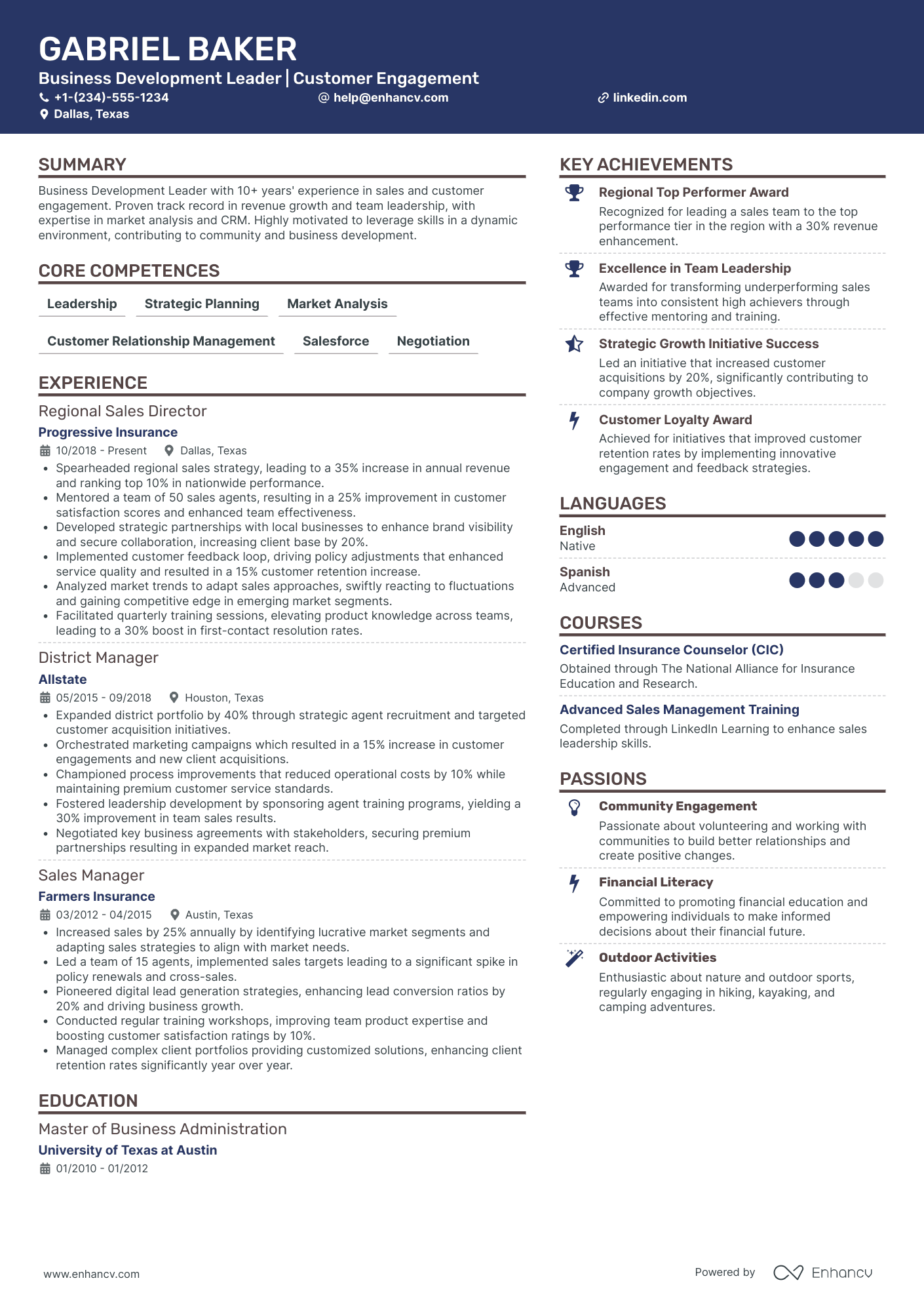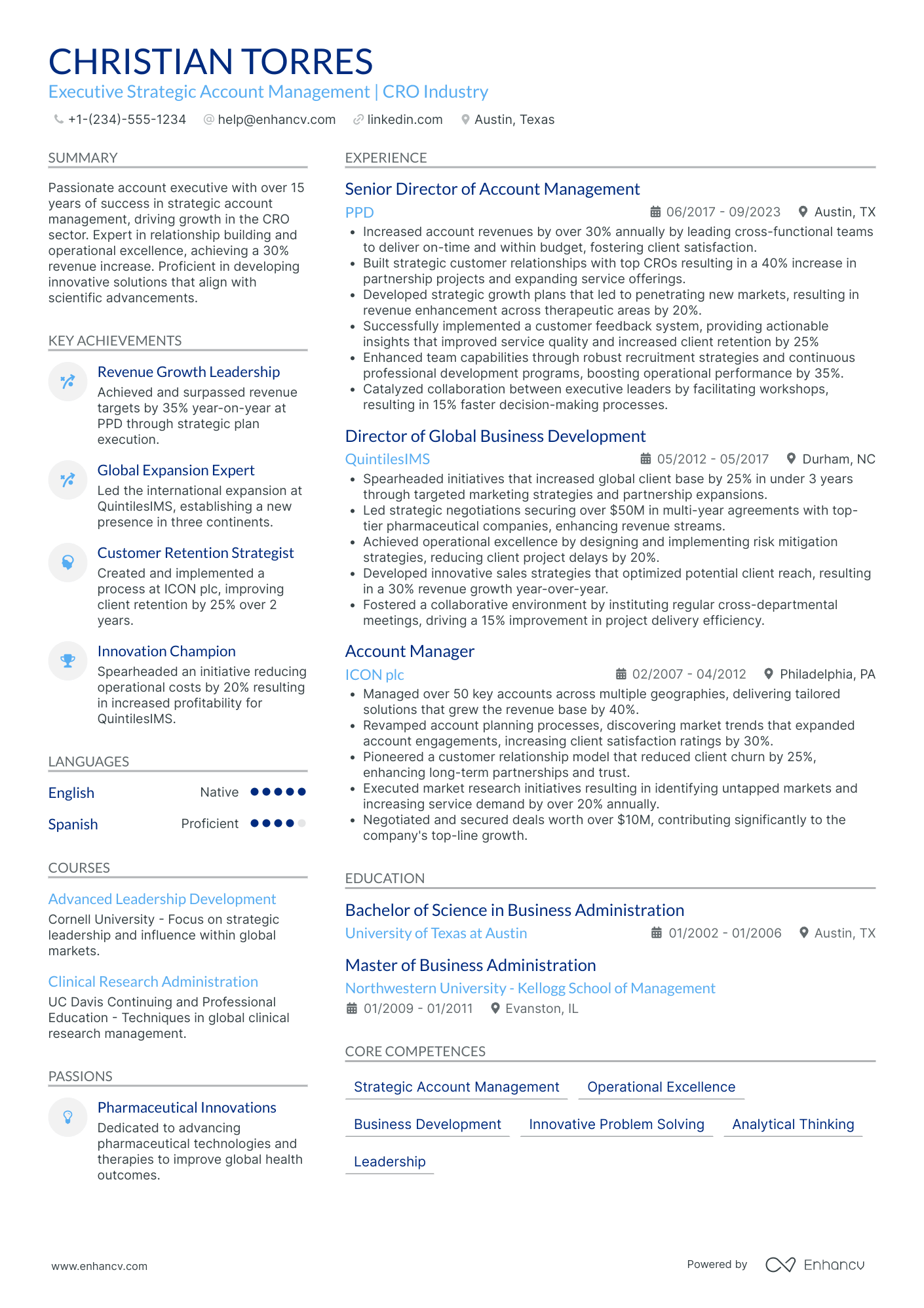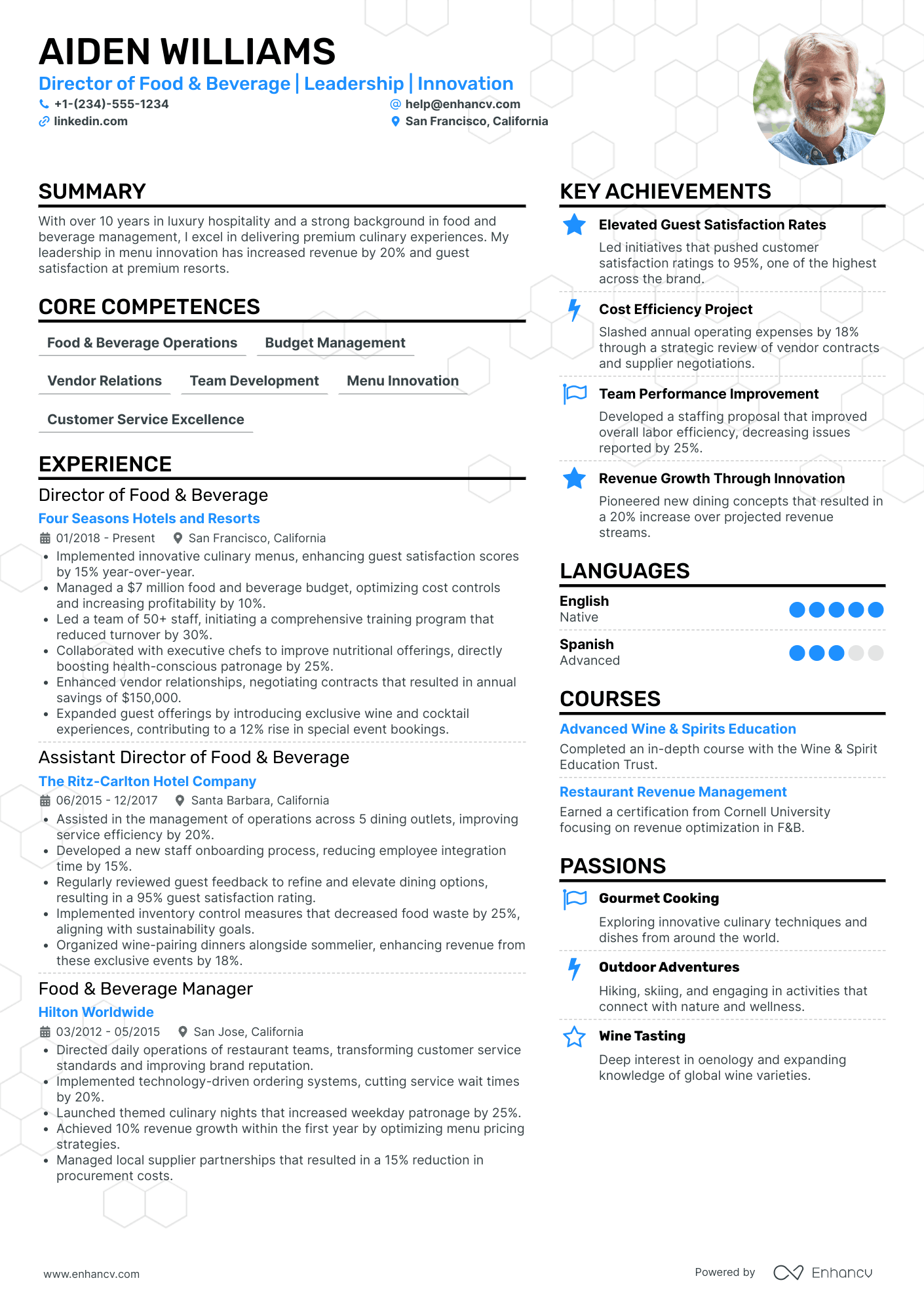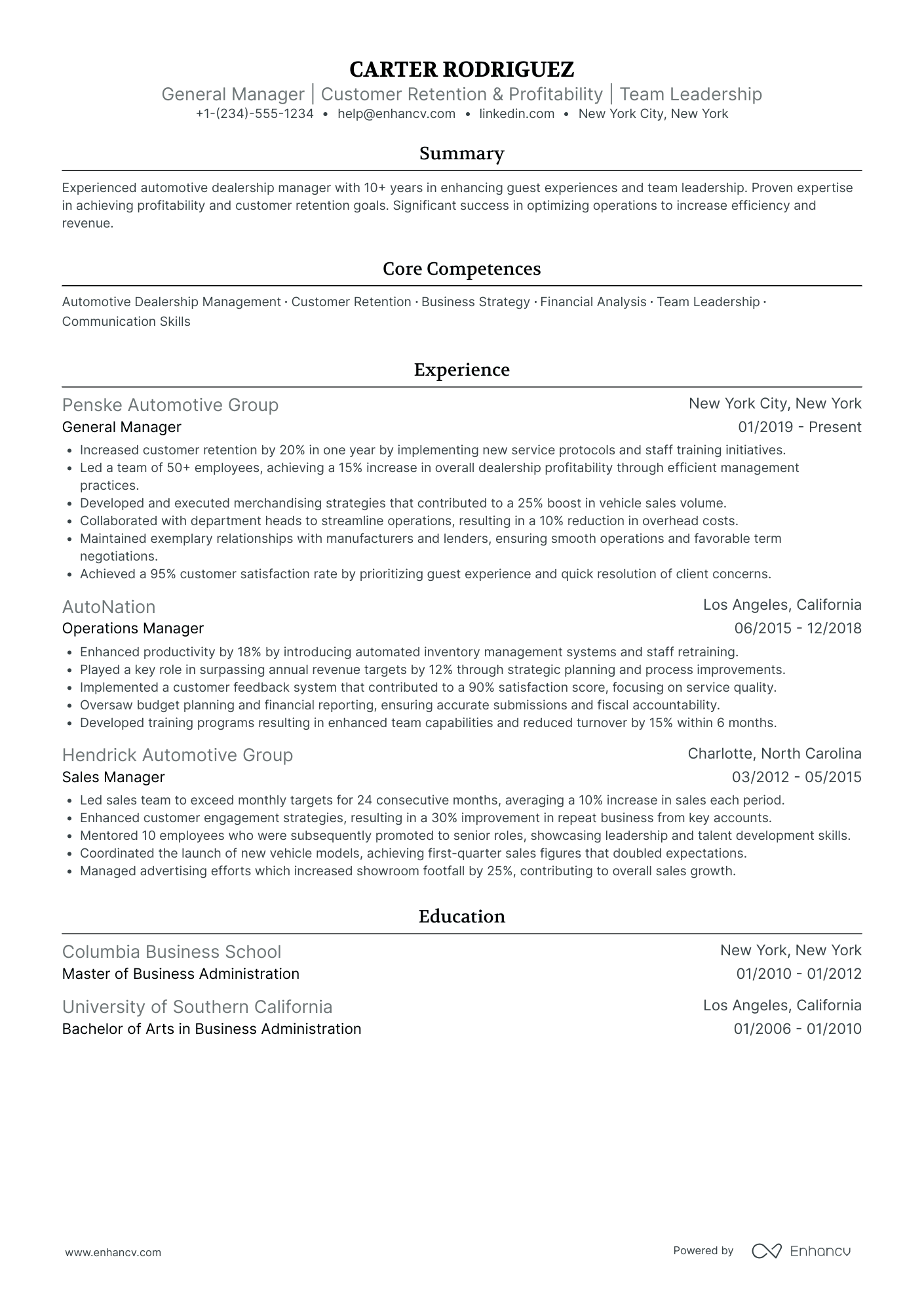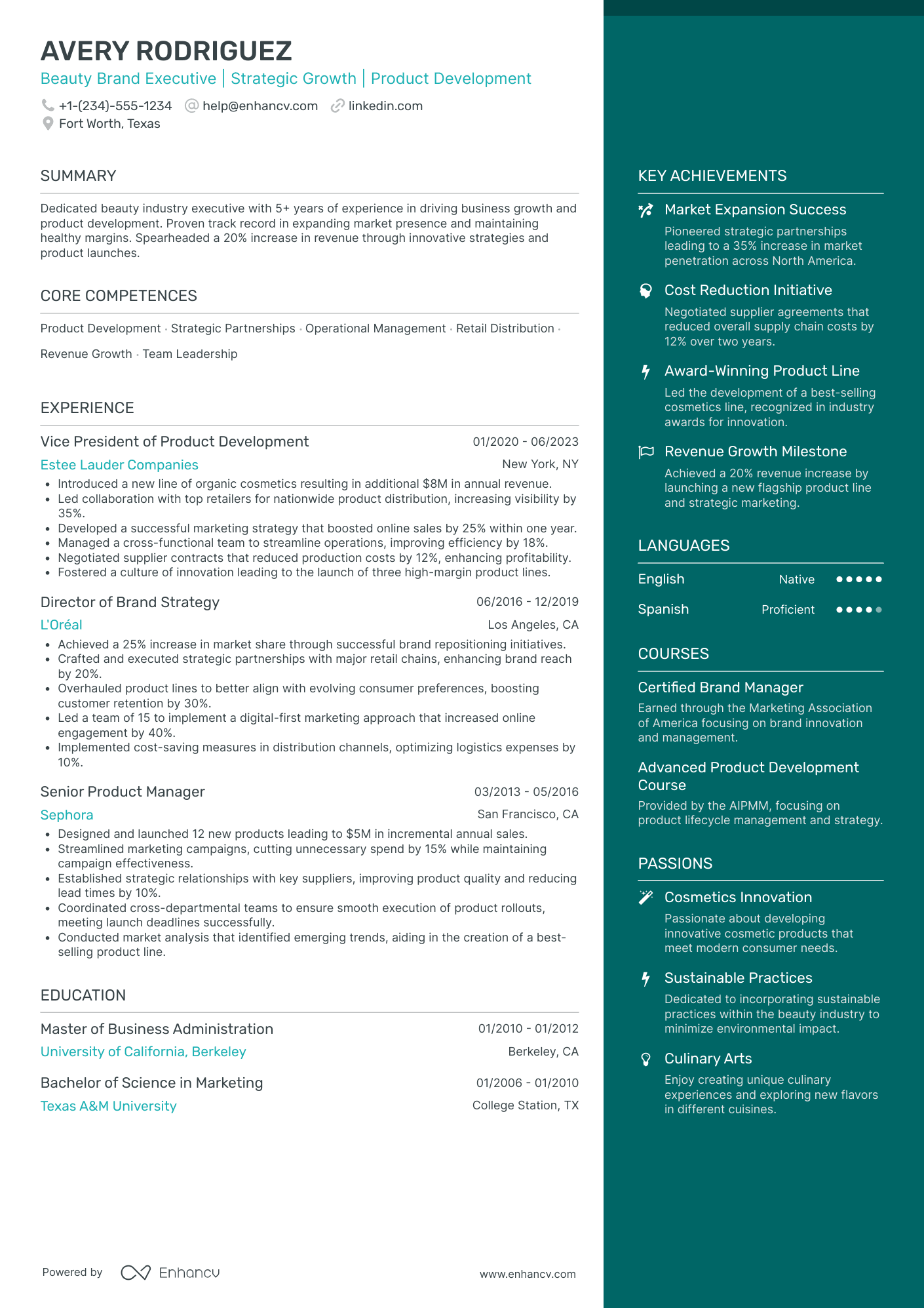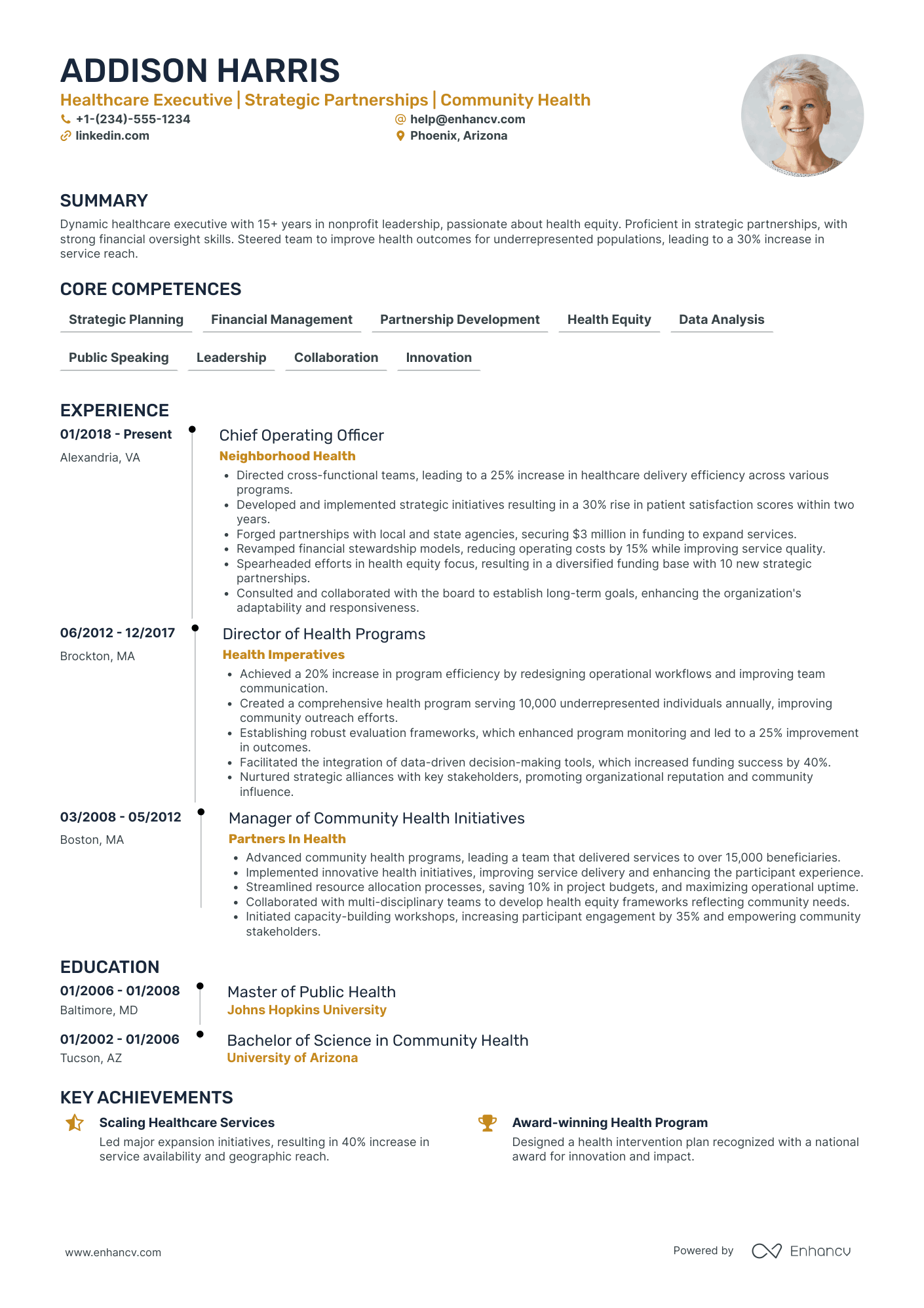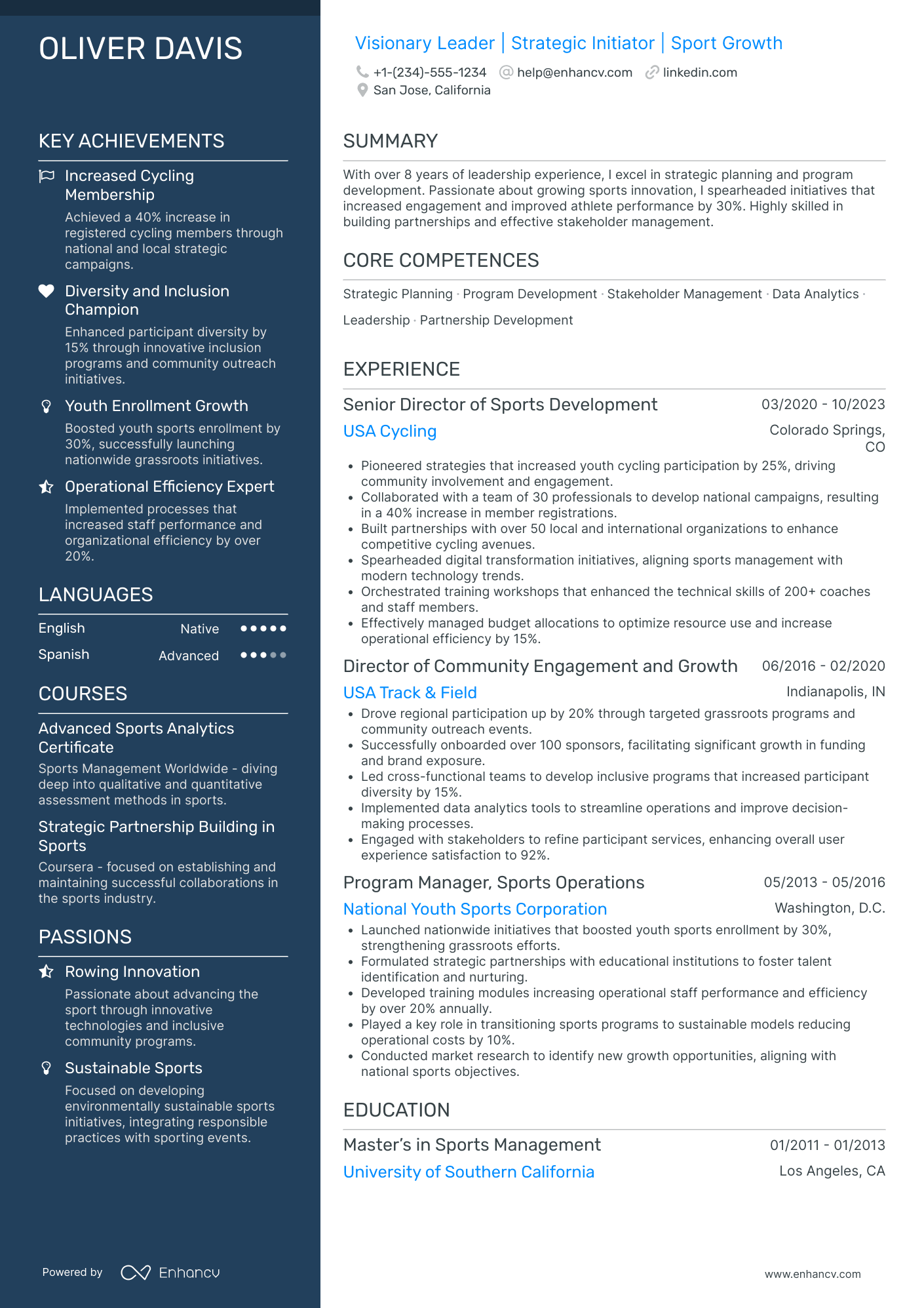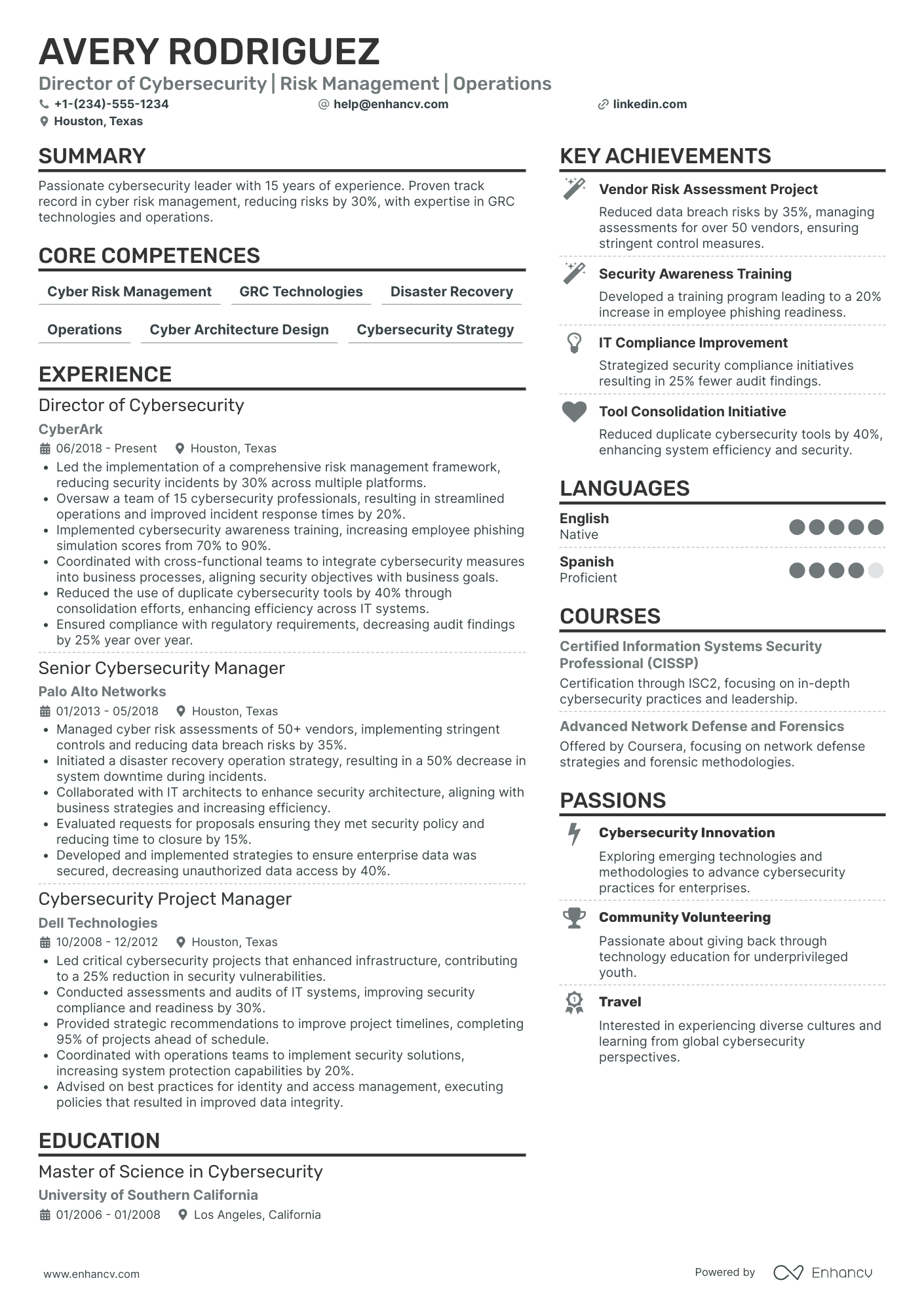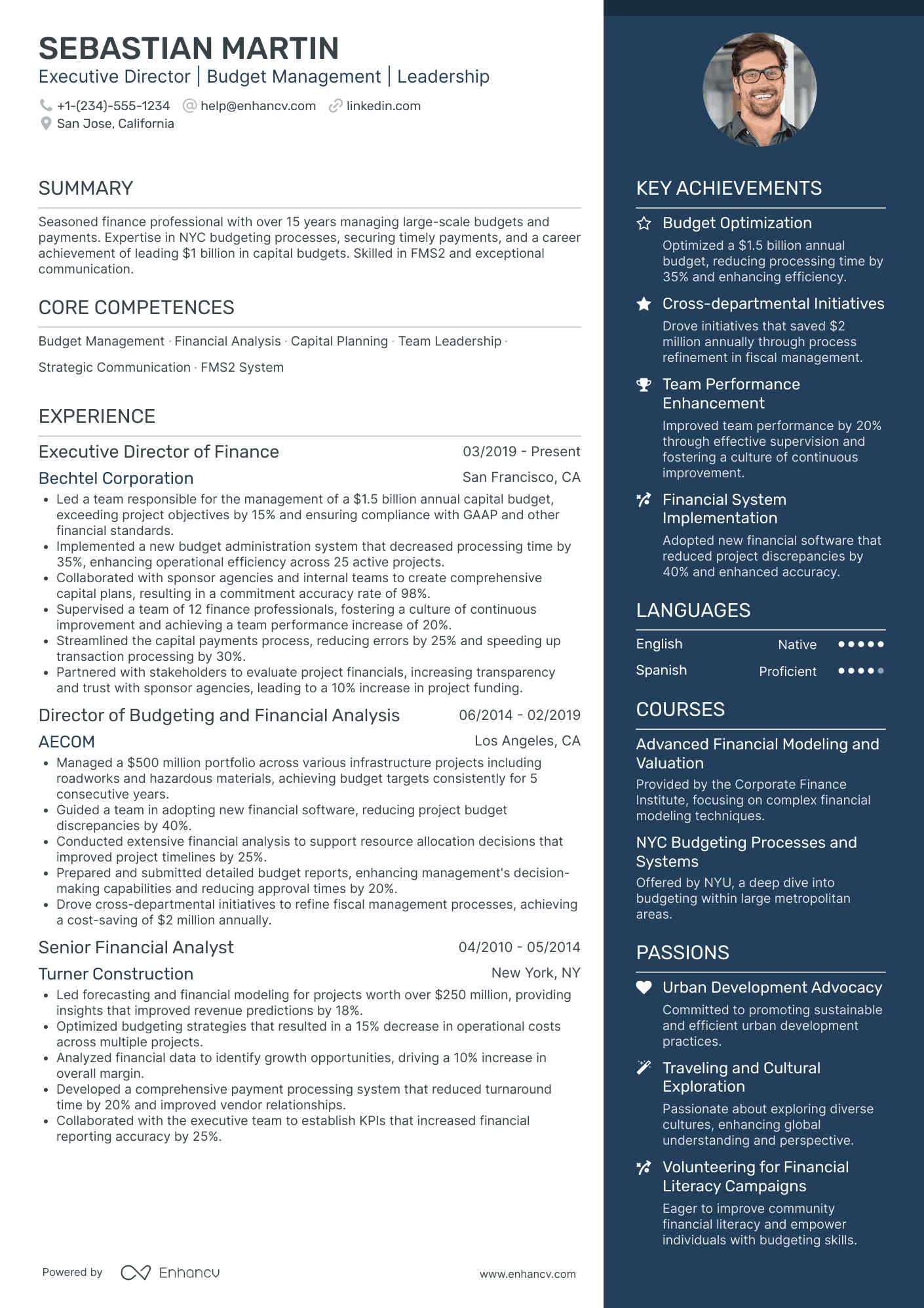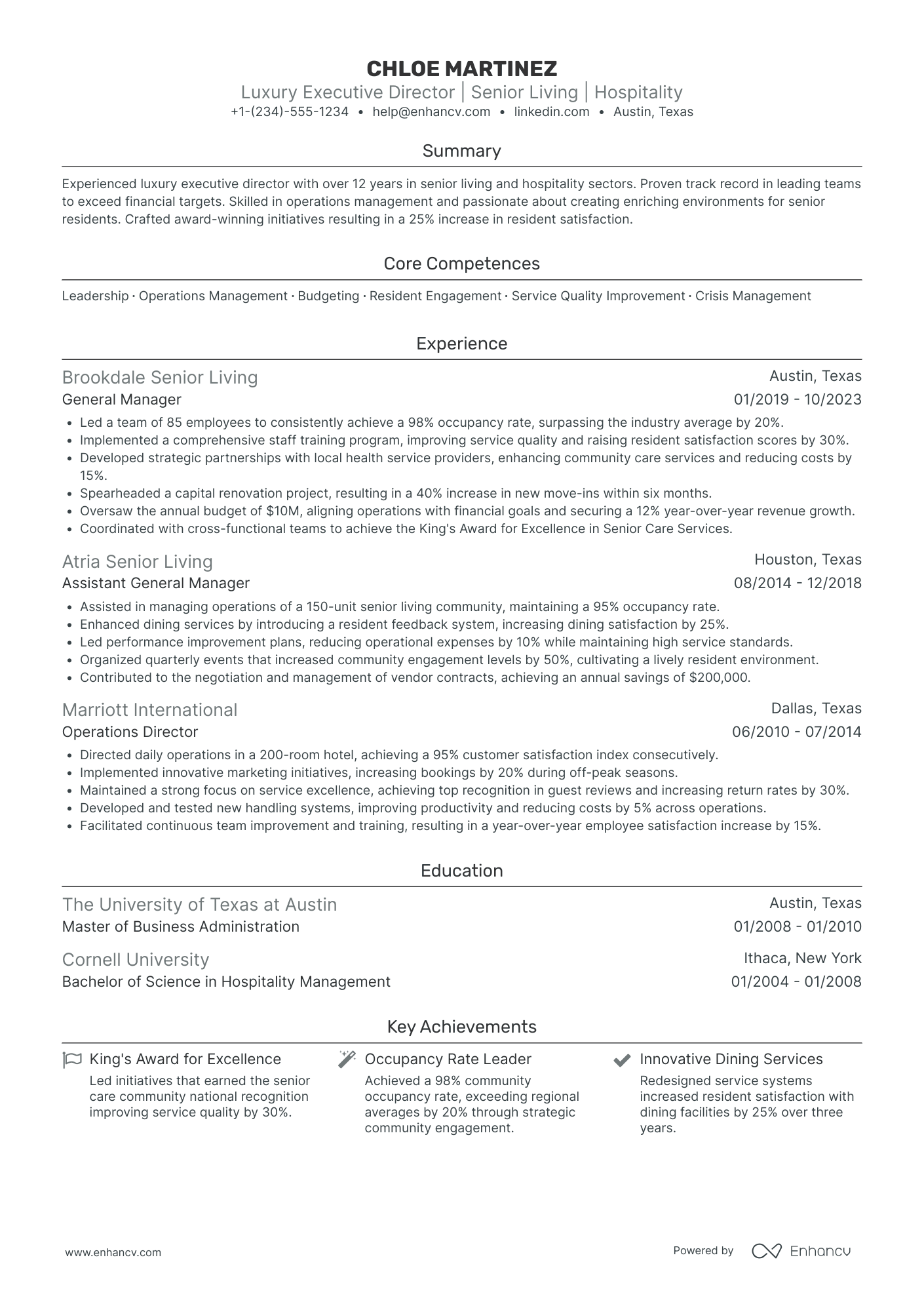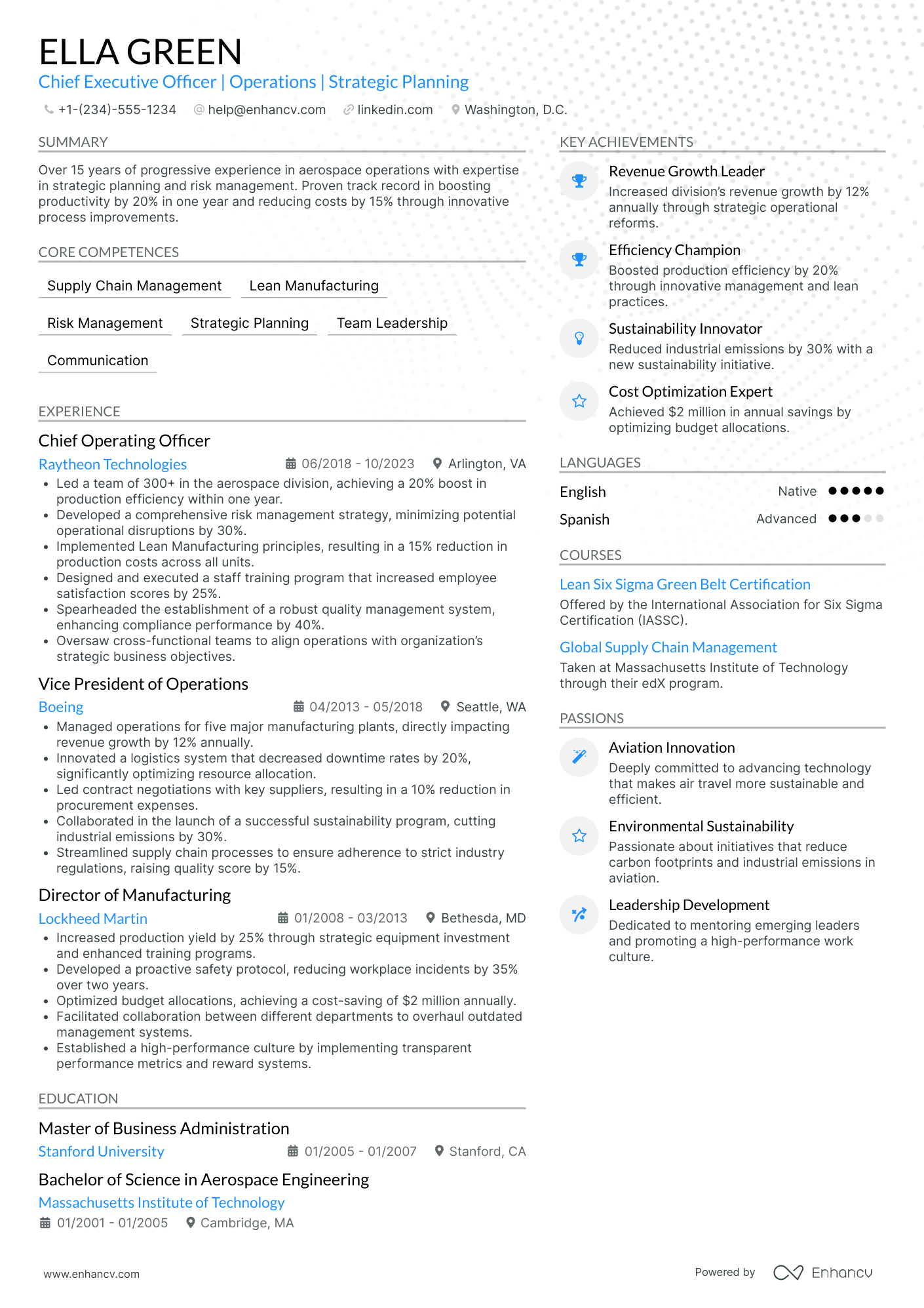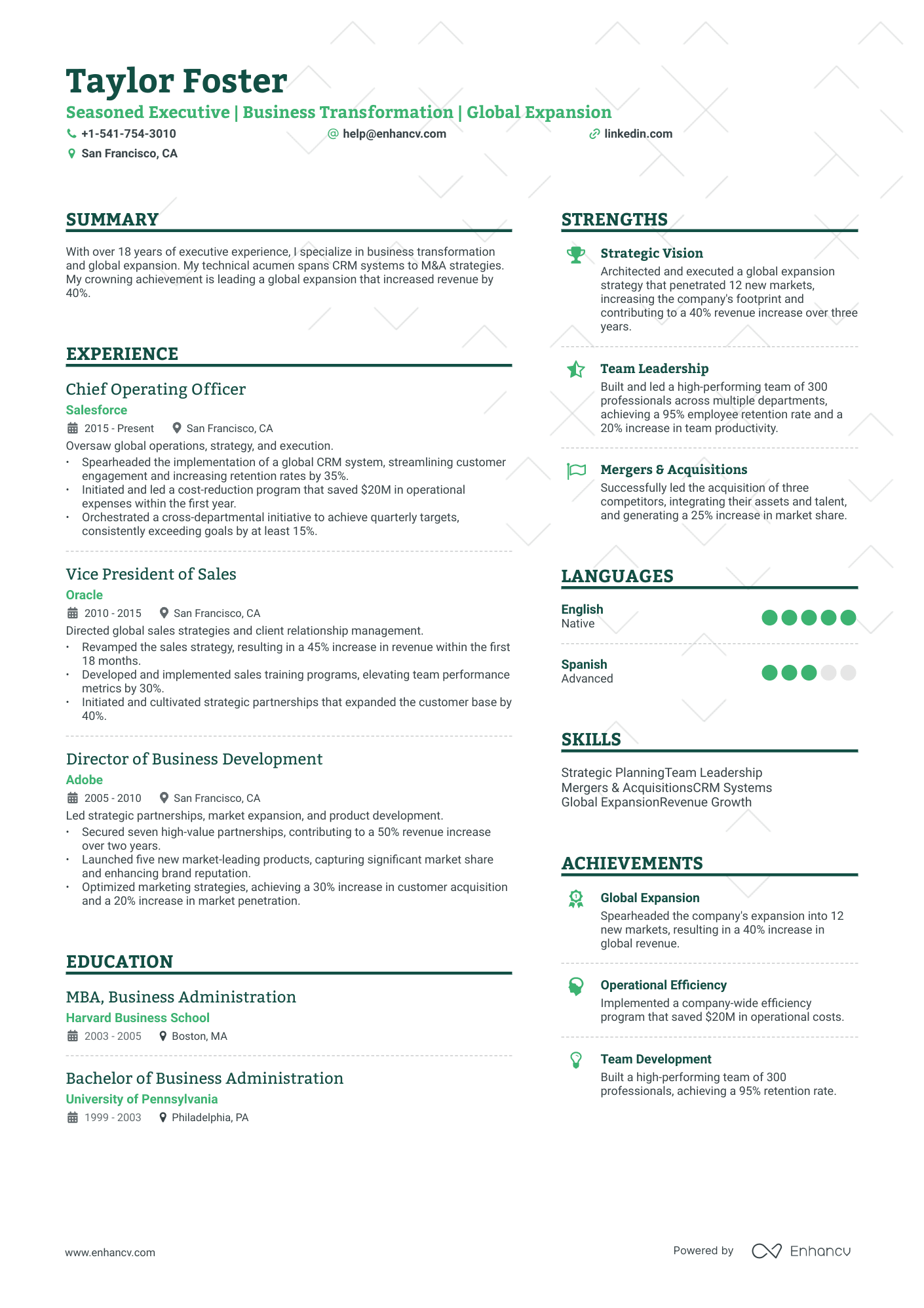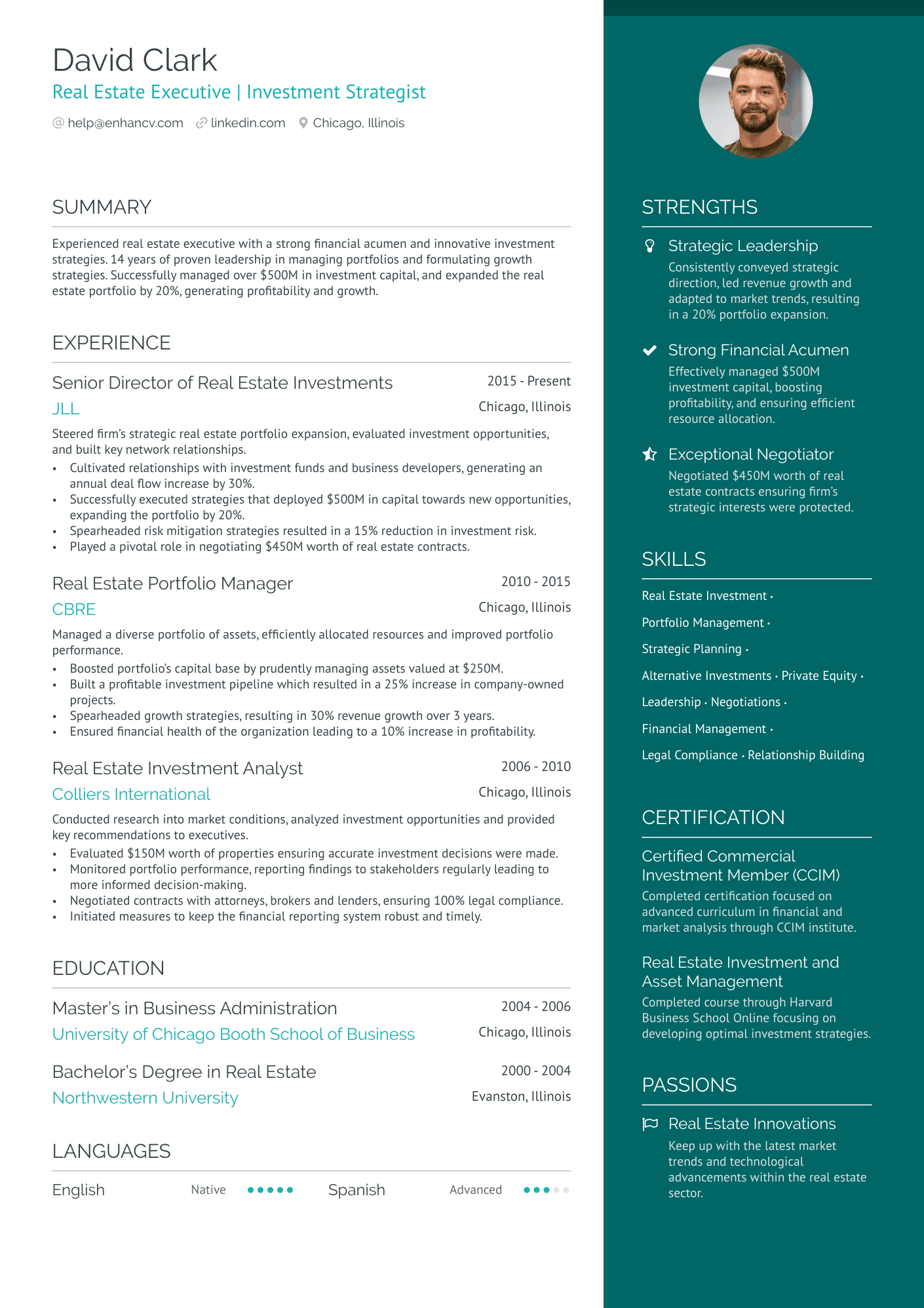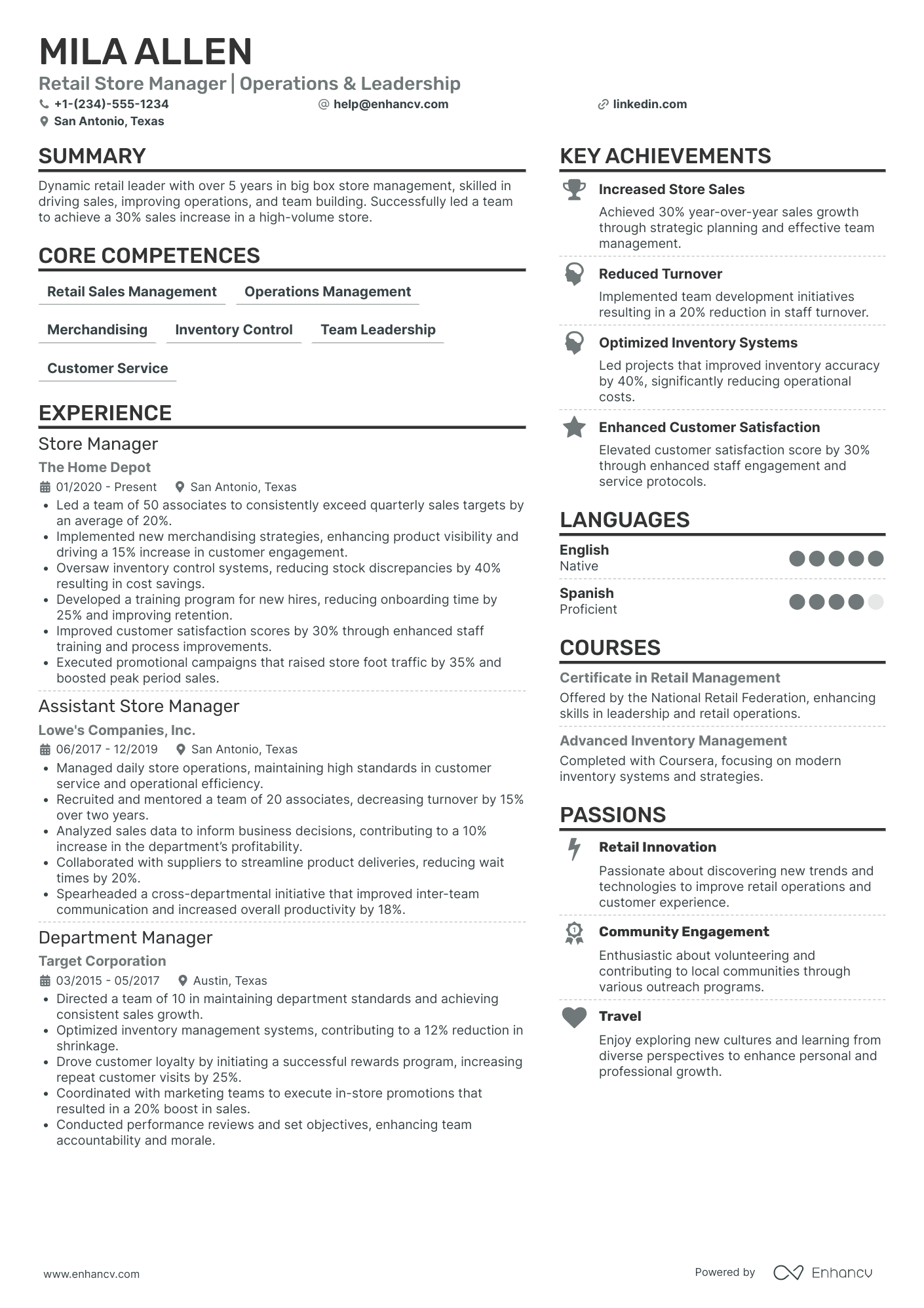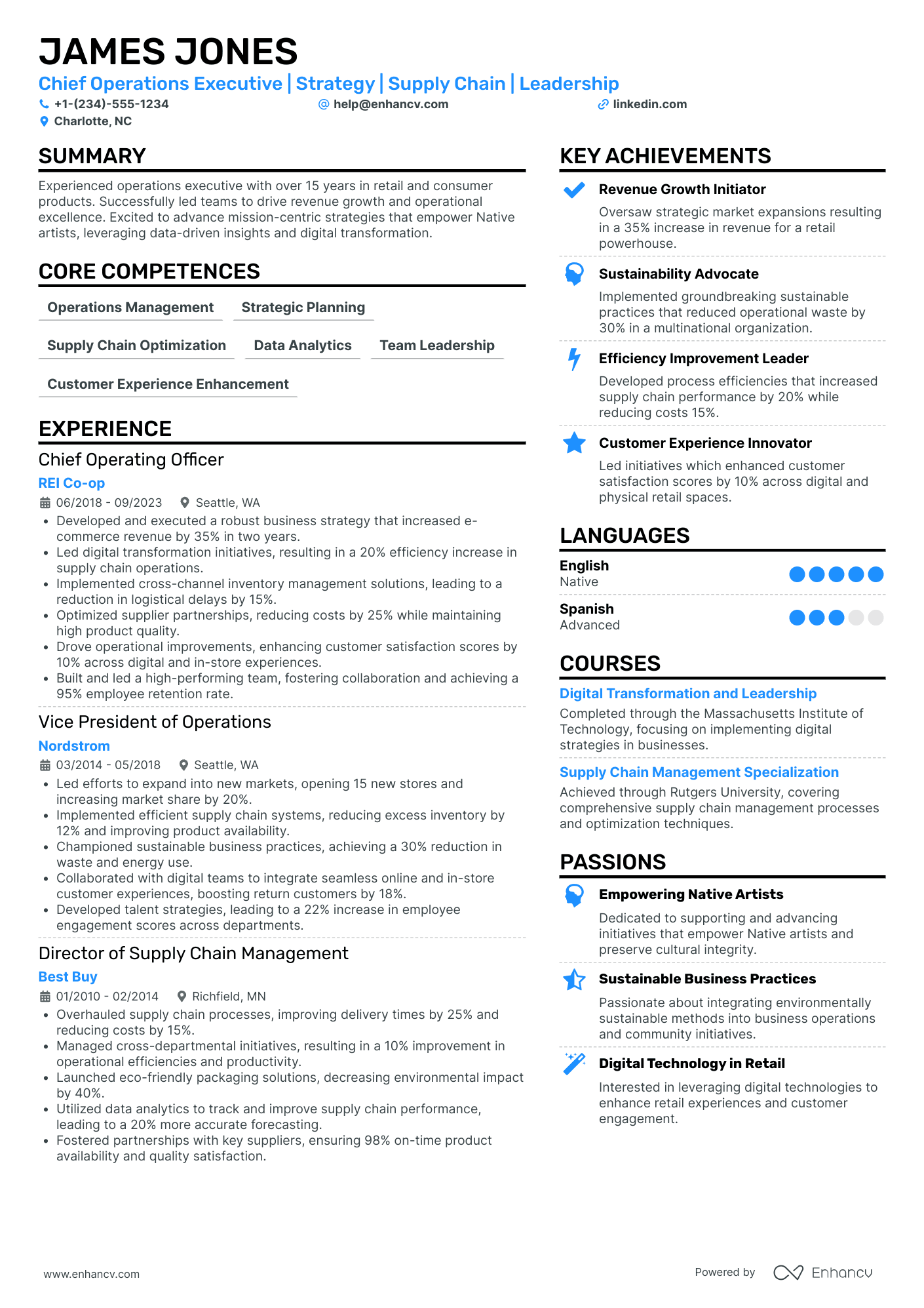Your next career milestone is right around the corner! And all that stands between you and becoming a chief executive officer is an impressive CEO resume.
Yet, how do you maintain a nice balance between achievements and corporate language? All without overcrowding your resume.
Our straightforward guide will help you:
- Crack the code on how to appeal to various companies, depending on their goals
- Analyze quality CEO resume examples to inform your writing process
- Build a powerful experience section the right way
Review other selected executive-level guides to see which one is more suited to your needs:
- Executive resume
- Board of Directors resume
- Fractional CEO resume
- Vice President resume
- Director resume
- Managing director resume
- Senior director resume
CEO resume example
Here’s what this resume does well:
- Highlights "Mergers & Acquisitions" under Strengths: Given the executive focus on business transformation, showcasing expertise in M&A adds weight to strategic capabilities.
- Emphasizes Harvard MBA in Education: For an executive role, a prestigious educational background can be a differentiator.
- Features Global Expansion under Achievements: A 40% increase in global revenue is a crowning feat that aligns with the role's focus on global strategy.
- Quantifies Achievements in Experience: Metrics like "increased retention rates by 35%" and "saved $20M in operational expenses" offer concrete proof of effectiveness and should be front and center.
How to format your CEO resume
What does a CEO resume look like? Well, it depends on the applicant’s background and the company offering the position.
Given that this is a C-level position, your candidacy will be reviewed by other executives and board members.
That’s why to get noticed, you must opt for a simple, streamlined design.
Here is what you can do:
- Use the reverse-chronological resume format: C-level professionals are busy. So, a more traditional CEO resume template will definitely be appreciated.
- Choose a modern CEO resume design: Using a tried-and-tested layout doesn’t mean you can’t customize your resume. Employ the company’s brand colors, but don’t go overboard.
- Make the most of your resume header: List your LinkedIn profile. As well as a link to a portfolio with all your statements, media appearances, and business insights.
- Show your career growth: Curate your experience section so that it displays the range of your skills. Emphasize how well you know the particular industry market.
- Keep your resume under two pages: While executive resume formats provide more room for you to shine the spotlight on board memberships and side projects, remember to be selective.
- Save your CEO resume as a PDF file: As a C-level professional, you can’t risk sending a scrambled document. Preserve the design and layout of your resume.
Remember, resume layouts can vary by country – for example, a Canadian resume format could look different.
Pro tip
CEOs are a company’s face. Polish your LinkedIn profile before submitting your resume for evaluation.
Board members and investors conduct a meticulous social media check to verify if the candidate’s views align with their own.
Especially on sensitive topics of current social issues, such as international conflicts and trade wars.
Is your resume good enough?
Drop your resume here or choose a file. PDF & DOCX only. Max 2MB file size.
The top sections on a CEO resume:
- Contact Information: Make sure you’re reachable by adding your LinkedIn. Or any other professional profiles you have, such as your GitHub.
- Executive Summary: Pitch your leadership skills, achievements, and expertise by writing a convincing executive summary.
- Professional Experience: Lead your experience section entries with measurable data and statistics.
- Board Memberships: Networking is not only an essential CEO skill, but it proves how entrenched you are in the particular business niche.
- Skills and Competencies: Tailor the skills section to the C-suite level abilities and duties mentioned in the job ad.
What recruiters want to see on your resume:
- Strategic Vision: Prove you have the ability to set and execute long-term goals for the company.
- Leadership Skills: Demonstrate you have the experience and expertise to lead teams and drive organizational change.
- Financial Acumen: Highlight cases in which you were responsible for considerable revenue growth, good budget management, and fiscal responsibility.
- Stakeholder Relations: You’re the link between the company and its board of directors, investors, and partners. Exhibit good relationship management skills.
- Industry Expertise: Display you are up to date with all the trends, challenges, and competitors in your business sector.
How to build an effective CEO resume experience section
Although your expertise and qualifications should be reflected everywhere on your resume, the experience section is by far the most important one.
That’s because it contains a condensed version of your work history with all the good and relevant bits highlighted.
As such, the big question, bothering all who strive for a C-suite position is how much experience to put on your resume.
The short answer is to add as much as you can. But there are a few caveats, which revolve around how much company research you’ve done beforehand.
If you’re applying for a CEO position at the company you’re already working for, you must already have a good grasp of what its culture is. And the board of directors will know this.
Instead, focus your attention on showing you have a good eagle-eye view of the business sector and the company’s competitors. Don’t forget to mention any connections to big industry players.
On the other hand, if you’re aiming to fill the CEO seat at a different company, make sure to research where it’s headed and what its current goals are.
Target your resume by adding examples of past work experience that resonate with your future employer’s interests. To do this, check the company’s:
- Website
- Annual reports for the last few years
- Media coverage
- Posted job ad
It may seem like too much work. Especially if you plan to offer your CEO skills and services to several companies and as such you would have to do this for each of your targets.
But there is a perfect reason for this thorough research.
Knowledge is power. Your potential employer's financial standing and strategy are indicative. Understanding them can hint at what type of candidate they are searching for.
For instance, imagine your potential employer is already a well-established company. In this case, they probably need someone with deep industry and technical knowledge.
By contrast, if the company is a startup or has had some recent financial troubles, the perfect candidate would have strong business acumen.
Someone with excellent leadership experience who will help the company through its struggles. And allow it to grow further within its particular business space.
So, don’t avoid including side projects that don’t fall into the traditional employment category.
Yet, regardless of which company you’ve targeted, any resume for an executive position must exhibit a clear career progression.
Rather than adding a laundry list of past duties, include tangible examples with measurable outcomes:
- Review the CEO job description and pick out all the core skills and experiences requested for the role.
- Match the requirements with examples from your own work history.
- Use the highlighted resume keywords to describe your experience.
- Include between 5 and 6 bullets for more relevant positions and 2 and 3 bullet points for other related experiences.
Take a look at the sample CEO experience section below:
- •Expanded the company's international market share.
- •Boosted YoY revenue for 2021.
- •Negotiated over 40 contracts for $2.6 billion
No board member worth their salt would look at this entry and say: “Wow, we’ve struck gold here!”
Some of the more glaring mistakes include:
- Missing company description: As you already know, executives don’t have much spare time. Don’t rely on them to click on the company website, even if it’s listed for their convenience.
- Insufficient context: Each bullet point begins with an action verb and contains some statistics. But there isn’t enough context to understand the impact of the achievements.
- No reference to the industry: With the company description missing, the reviewer would have to rely on hints in the name of the company and the bullet points. Yet, there are none.
But once you add all the missing pieces of information, the entry becomes much more effective.
- •Expanded the company's international market share by 74% to 13% through the introduction of Libros Ltd. to the East Asian scientific community and publishing market.
- •Boosted YoY revenue for 2021 by 25% by launching a special collector's edition of the top 50 philosophers of all time.
- •Negotiated over 40 contracts for $2.6 billion with several universities across the US and Japan, after organizing a fundraising event, where 12 first editions were auctioned off.
Now board members know that Ellis is not only in the book publishing industry, but she is also very involved with the related academic community.
If Ellis’ potential employer was searching for someone who’s very knowledgeable about philosophy from a scientific standpoint, she would be the perfect candidate.
But if the company needed someone with outstanding management skills, the focus of the examples would shift.
Consider the following leadership experience resume example:
- •Overhauled existing business procedures and practices.
- •Raised funds in Series B round.
- •Signed service contracts with the State of California.
Again, it’s not as powerful as it could be. Apart from the obvious lack of context in the bullet points, Ellis has:
- Not linked to the company’s website: Not every start-up is talked about equally. If media coverage is scarce, investors would be thankful if they didn’t have to search for additional information.
- Been vague about the Series B funding round: Details about fundraising are usually publicly available. Ellis should have taken the opportunity to boast about her leadership abilities.
- Been ambiguous about some of her actions: She may have wanted to flaunt her management skills in the first bullet. But there is no explanation as to why an overhaul was needed.
Here is a much better version of the above experience entry:
- •Overhauled existing business procedures and practices, which no longer served purpose due to the company's rapid growth, thus saving $1.9 in yearly costs.
- •Raised $46 million in Series B funding, just 12 months after the company's Series A round.
- •Signed 28+ service contracts, amounting to a total of $43 million, with 7 counties across the State of California for the delivery of medication and food to house-bound single people during the pandemic.
How to quantify impact on your resume
The examples above clearly show how important it is to list measurable outcomes on your CEO resume.
Ultimately, C-suite executives must be results-oriented. So, data and numbers are key here.
With this in mind, what type of experience is easy to quantify and would look good on your resume?
Some of them include:
- Fiscal responsibility and knowledge: Yes, the financial side of running a company typically falls on the CFO. Draw attention to your ability to not take unnecessary risks and save money.
- Growth and development: Highlight cases, where your expertise has resulted in considerable revenue increase or market expansion.
- Attention to detail: Although you have to have a good understanding of the big picture, the devil is in the details. Demonstrate your ability to take advantage of opportunities, when they present themselves.
- Scale and scope of your work: Mention how many people you’ve managed or how many relevant projects you’ve overseen.
- Industry involvement: Point to your ability to network by listing significant public appearances, such as product presentations and industry summits.
- Key performance indicators tracking: Indicate how your work has influenced your past employers. Display your goal-setting skills and ability to run seamless business operations.
How to describe your hard and soft skills on your resume
Depending on what type of professional the company is searching for, your CEO resume skills section will have a diverse mix of tech and social skills.
Technical abilities, or hard skills, indicate your industry and field-specific knowledge.
If your business niche is highly technical, such as healthcare, having a science-based background is a must.
In addition, given this is a C-Suite level position, you’ll have to exhibit a variety of soft skills, such as leadership and relationship building.
Display your ability to communicate well with mid-management staff, partners, and board executives.
To describe your CEO skills properly on your resume:
- Start your entry with an action verb.
- Report your relevant achievement, including numbers and data to support your claim.
- Provide context for a bigger impact.
Remember, whether it’s your skills or your job experience, you must quantify your accomplishments.
Best hard skills for your CEO resume
- Strategic Planning
- Financial Analysis
- Budget Management
- Team Leadership
- Project Management
- Risk Assessment
- Data Analytics
- Mergers & Acquisitions
- Supply Chain Management
- Corporate Governance
- Stakeholder Management
- Business Development
- Change Management
- Contract Negotiation
- Market Research
- Crisis Management
- Performance Metrics
- Revenue Growth
- Investor Relations
- Regulatory Compliance
Best soft skills for your CEO resume
- Leadership
- Communication
- Emotional Intelligence
- Decision-Making
- Problem-Solving
- Adaptability
- Negotiation
- Conflict Resolution
- Time Management
- Strategic Thinking
- Team Building
- Delegation
- Resilience
- Empathy
- Accountability
- Innovation
- Networking
- Public Speaking
- Active Listening
- Motivation
How to add your certifications and education to your resume
It’s true, not every CEO out there has a college degree. Yet, some industries demand you have at least a bachelor’s or a master’s in the respective field.
Either way, the education section is there to cement your professional credentials and qualifications.
To get noticed for your academic background:
- List the name of your degree and the issuing institution.
- State the location of your college or university.
- Cite the date of course completion.
- Include 1-2 related achievements, especially if you’ve managed to apply your skills in practice.
- Add relevant course projects, courses you’ve taken, or papers you’ve authored.
- Mention if you’ve been a member of a fraternity or a sorority, or made the dean’s list.
You can list your GPA if it’s required in the job ad, but it’s not necessary.
For instance:
- •Increased EBITDA for Pharma Dream Inc. by 35% for 2020 by taking business risks and effectively leveraging strategies learned through the course.
Pro tip
Even if you don’t have a college degree, never list your high school diploma. Instead, reference any associate degree or upskilling course you’ve taken.
Needless to say, if you have an MBA, definitely list it like so:
Best certifications for your CEO resume
- Certification in Mergers, Acquisitions and Alliances (IMAA)
- Mergers & Acquisitions Professional (M&AP)
- Certified Manager Certification (CM) by ICPM
- Certified Management Accountant (CMA) by IMA
- Certified Sales Professional (CSP) by MRERF
- Financial Risk Manager (FRM)
- Accredited Business Valuator (ABV)
- Project Management Professional (PMP) by PMI
- Professional Certified Marketer (PCM) by AMA
- Program Management Professional (PgMP)
How to write your CEO resume summary or objective
Before we delve into how to write the best elevator pitch of your life, let’s examine the different types of personal statements you can write.
The first one is the resume objective. It is a short paragraph of no more than 100 words, which depicts your top skills, 1 or 2 job-related achievements, and certificates.
The other one is the resume summary. As its name suggests, this is also a short text, describing your best industry achievements and core professional skills.
Both serve as a pitch to potential employers.
But there are two major differences:
- The identity of the applicant
- The focus of the text
Generally, the objective is used by college grads and professionals who’ve decided to switch their career.
Hence, the text aims to show how the candidate’s skills will benefit the company.
In turn, the summary is used mainly by established professionals. Its purpose is to shine the spotlight on the applicant’s vast expertise and accomplishments.
What does this all mean when it comes to your resume?
Logic dictates that as a tenured expert, you should craft a CEO resume summary. But don’t be so quick to dismiss the objective.
Consider the position you’re applying for.
If the company is in search of a skilled leader, the role allows for a diverse background in terms of industry. Similar to someone changing their career path.
In this case, it’s best to write a resume objective.
Yet, if the role demands very specific technical expertise, it’s best to craft a CEO executive summary for your resume.
First, have a look at the resume objective below:
The sample objective is very vague. Rather than relying on key skills and accomplishments, the applicant has added too many adjectives.
Plus, there isn’t any verifiable data, including exactly how many years of experience the candidate CEO has.
More importantly, the objective sounds self-centered. There’s no mention of how the applicant can help the company achieve its goals.
Once we account for the mistakes above, a better edit of the example will be:
Take a look at another example:
This candidate has opted for a resume summary to highlight their vast industry knowledge.
But instead of drawing attention to their expertise, they’ve listed general CEO skills with no pertinent examples.
See how being more specific with the information you provide can improve your resume summary:
Optimize your resume summary and objective for ATS
Drop your resume here or choose a file.
PDF & DOCX only. Max 2MB file size.
Is there anything else you can add to your CEO resume to impress executives?
Of course!
But before including extra sections, consider how much space you have left.
If you still have some resume real estate to spare, you can attach extra resume sections, such as:
- Association memberships, such as ASAE, AMA, BNI, etc.
- Presentations or publications with your industry insights, forecasts and trends
- Awards and prizes you’ve won over the years
- Foreign languages - especially if the company is trying to expand its operations overseas
How to put a day in the life section on a resume
The best way to show your compatibility with the company’s culture is to share how you spend a usual day at work.
You don’t have to get into details.
Just state which are the 5 or 6 core activities that take up most of your time during the day. By doing so, executives can see where your personal and professional priorities lie.
Here is how to do it:
Key takeaways
Now, let’s review what it takes to write an outstanding CEO resume:
- Research your target company before you start writing. Never send the same resume to different companies.
- Refine your LinkedIn and any other professional profiles you have, before linking them in the resume header.
- Build a convincing resume summary by mentioning industry-specific accomplishments and skills.
- Craft an experience section that reflects the requirements listed in the job description.
- Remember to always quantify your achievements and provide context to make them more impactful.
- Tailor your skills section according to the type of candidate the company is searching for.
- Reference relevant academic publications or papers you’ve authored in the education section.
Chief Executive Officer resume examples
By Experience
Startup Chief Executive Officer
Interim Chief Executive Officer
By Role
Founder & CEO
Modern CEO
Non-Profit CEO
Real Estate CEO
Co-Chief Executive Officer
Digital CEO
- Clear and structured presentation - Jack Allen's resume is laid out with precision, making it easy to follow their professional journey. Each section is well-delineated, using concise bullet points and clear headers that allow the reader to quickly digest key information. This clarity of structure highlights relevant experiences, skills, and achievements without overwhelming the reader with unnecessary details.
- Impressive career growth and adaptability - The resume demonstrates Jack Allen's upward career trajectory, moving from a Sales and Marketing Manager role to a Managing Director position. It reflects his ability to adapt and thrive in different environments, having worked across various locations and companies, each with unique market demands. His progression is marked by increasing responsibilities and consistent performance in business development and operations management.
- Leadership and team collaboration - Jack's leadership abilities are underscored by his experience in managing large teams and fostering a culture of innovation and collaboration. The resume provides examples of his effectiveness in team leadership, including increasing team productivity and spearheading cross-departmental strategies. These insights into his leadership style highlight his ability to build cohesive teams that drive business success.
Healthcare CEO
- Content Presentation and Clarity - The resume is structured in a highly organized manner, employing clear sections that succinctly outline the candidate's experience, education, skills, and achievements. Each section is well-defined, allowing the reader to easily navigate through the various elements of Grace Jackson's professional history.
- Career Trajectory and Progression - Grace Jackson demonstrates a compelling career progression, beginning as a Director of Healthcare Services, advancing to Vice President of Operations, and subsequently attaining the role of Chief Operating Officer. This trajectory reflects a consistent upward movement in responsibilities and leadership roles within the healthcare industry.
- Unique Industry-Specific Elements - The resume showcases Grace's expertise in healthcare management through her involvement in electronic health record systems and strategies to boost patient satisfaction. Her initiatives to integrate new technologies highlight her understanding of industry-specific tools essential in modern healthcare administration.
SaaS CEO
- Comprehensive Career Advancement - Abigail Hall's career trajectory is marked by significant growth, evident from her progression from a Marketing Manager to a Senior Vice President of Strategy and ultimately to a Managing Director role. This steady ascent showcases her ability to take on increasing levels of responsibility and impact revenue significantly, demonstrating her capabilities in leadership and strategic execution.
- Effective Communication of Achievements - The resume succinctly presents each achievement with quantifiable results, such as a 25% revenue increase at Reputation.com and a 50% rise in user engagement at Yelp. These specifics not only demonstrate her effectiveness in previous roles but also highlight her ability to drive measurable business success, affirming her strategic impact across different companies.
- Strategic Cross-Functional Leadership - With extensive experience in managing cross-functional teams, Abigail showcases a knack for enhancing business performance through collaboration. Her work aligning engineering and product teams to meet customer expectations exemplifies her adaptability and effectiveness in leading diverse teams to achieve common business objectives.
Global CEO
- Effective Presentation and Clarity - The resume is structured with clarity and ease of navigation, making it simple for stakeholders to scan and identify key information swiftly. Each section is concise, presenting career highlights and achievements in a manner that is easily digestible.
- Strategic Career Progression - Carter Rodriguez's career trajectory demonstrates clear upward movement, from Director of Global Programs to CEO, showcasing their growth and the increasing breadth of their responsibilities in the global health sector. This trajectory indicates their strong leadership and ability to take on increasing operational complexities.
- Notable Industry-Specific Expertise - The resume integrates specific industry methodologies, such as innovative technology solutions and performance management systems, indicating Rodriguez's technical depth and his strategic approach to improving health service delivery.
AI CEO
- Effective Career Trajectory Showcase - Leah Torres's resume effectively highlights her progressive career path in the HealthTech sector. It showcases her growth from Director of Product Management at GE Healthcare, to founding her own startup, and eventually becoming the Chief Innovation Officer at Intuitive Surgical. This illustrates her upward career movement and increasing responsibilities, evidencing her leadership and expertise in the industry.
- Strategic Impact and Innovation Focus - The accomplishments listed in the resume emphasize Torres's strategic contributions and innovative initiatives that significantly impacted business outcomes. For instance, securing $50M in Series B funding and leading the development of AI-driven platforms underscore her ability to not only innovate but also to translate these innovations into substantial business successes.
- Cross-Functional Leadership - Leah's resume emphasizes her capacity to lead cross-disciplinary teams, as seen in her roles where she managed teams composed of engineers, medical experts, and professionals specializing in AI. This demonstrates her adaptability and soft skills in fostering collaboration, creativity, and excellence in diverse team settings, which are crucial in dynamic health technology environments.
Operations CEO
- Impressive Career Growth and Leadership - Ella White's career trajectory demonstrates significant growth and leadership development over the years. Starting as a Director of Youth and Family Services, she advanced to the Chief Operations Officer role at the YMCA. Her career path highlights a consistent upward trajectory within renowned organizations, underscoring her capability to excel in executive leadership and strategic roles.
- Clear and Structured Presentation - The resume is well-organized, with clearly defined sections that make it easy to navigate through her extensive experience. Each position includes concise bullet points that emphasize key achievements and responsibilities, allowing potential employers to quickly grasp her skills and contributions. This approach not only enhances readability but also effectively communicates her professional narrative.
- Strategic and Impactful Achievements - The resume highlights Ella's ability to deliver strategic and impactful outcomes through her leadership roles. Her achievements, such as spearheading a digital transformation strategy, leading a successful capital project, and significantly increasing membership and program participation, demonstrate her effectiveness in driving growth and fostering community development. These accomplishments underscore her capability to create meaningful business and social impacts.
By Industry
Chief Executive Officer in Non-Profit
- Clear and Structured Content Presentation - The resume is well-organized and concise, effectively segmenting information into intuitive sections like experience, education, and skills. Each section is clearly labeled and easy to navigate, ensuring that the reader can quickly comprehend the candidate’s qualifications and background.
- Impressive Career Trajectory - Benjamin's career growth is evident, with a clear progression from Program Manager to Director of Development, and finally to Chief Operating Officer. This upward trajectory within the education and nonprofit sectors highlights his increasing levels of responsibility and leadership over time.
- Achievements with Significant Business Impact - The achievements are not just focused on numbers but also underscore their broader impact. For instance, increasing literacy rates by 40% and raising $4.5M demonstrates a positive influence on both community welfare and financial growth, supporting organizational sustainability and mission fulfillment.
Chief Executive Officer in Technology
- Effective Clarity and Structure - The resume is presented in a clear and organized manner, with the use of concise bullet points that systematically lay out the candidate's role within each listed experience. Each section is well-defined, providing a snapshot of their professional journey and skills, ensuring quick and easy readability for potential employers.
- Demonstrated Career Growth and Adaptability - Ella Green's career trajectory showcases a consistent path of growth, moving from roles in product development to strategic directorship and eventually to a COO position. The inclusion of diverse industry engagements from consumer products to prop-tech underlines her versatile adaptability to different market demands and challenges.
- Strategic Use of Advanced Technologies - A notable aspect of the resume is the emphasis on Ella's proficiency with advanced tools and methodologies, particularly in the use of AI-driven data analytics and DevOps practices. These unique industry-specific elements highlight her capability to innovate and implement tech-driven strategies that have a significant impact on business operations.
Chief Executive Officer in Manufacturing
- Impressive Career Progression - Zoe Thompson's resume demonstrates a clear and impressive career trajectory with steady progression from Operations Manager to Executive Director within leading defense technology firms. This growth reflects both their expanding leadership capabilities and increasing industry expertise.
- Impactful Business Achievements - The resume highlights significant business achievements including a 35% increase in market share at Raytheon Technologies and a 25% revenue growth at Lockheed Martin. These accomplishments are not only numerically impressive but also demonstrate Zoe's ability to drive organizational success through strategic planning and resource management.
- Leadership and Cross-functional Expertise - Zoe's experience leading large cross-functional teams, evident from managing a team of over 200 employees at Raytheon, showcases her adeptness in leadership. Her ability to drive operational improvements and align projects with strategic objectives further underscores her strong leadership skills and adaptability across various departments.
Chief Executive Officer in Finance
- Structured for optimal clarity and impact - The resume is expertly organized, beginning with a succinct summary that sets the stage by highlighting over a decade of experience in corporate banking. It employs clear section headers and bullet points that make achievements quickly accessible, ensuring key information stands out amid detailed content.
- Progressive career advancement - Elijah Brown’s career trajectory reveals a clear path of growth, advancing from a Corporate Banking Associate at JPMorgan Chase to Vice President of Corporate Banking at Wells Fargo. This progression illustrates his expanding influence and leadership responsibilities, indicating a successful climb within the banking industry ladder.
- Strong emphasis on strategic planning and leadership - The resume goes beyond routine responsibilities by emphasizing Elijah's strategic capabilities. He is credited with a 40% revenue increase and a diverse range of leadership accomplishments, including fostering high-performing teams and enhancing diversity and inclusion, which underscores his capability in steering transformative initiatives.
Chief Executive Officer in Retail
- Structured and Clear Presentation - The resume's layout is concise and well-organized, highlighting key information such as experience, education, skills, and achievements in a clear manner. This structured approach allows hiring managers to quickly grasp the candidate's capabilities and career progression.
- Diverse Industry Experience - Mila Allen's career trajectory showcases a steady rise through the ranks in the retail industry, with significant roles at major companies like The Home Depot, Lowe’s Companies, Inc., and Target Corporation. Her promotions reflect a strong capacity for leadership and increasing responsibility over time.
- Impactful Achievements with Business Relevance - The achievements section is particularly impactful as it not only provides impressive quantifiable metrics, like a 30% increase in store sales, but also highlights strategic initiatives that led to these outcomes. This demonstrates Mila's ability to drive significant business results.
Chief Executive Officer in Energy
- Impressive Career Progression in the Energy Sector - Joseph White’s resume shows a clear trajectory of growth and responsibility, transitioning from Director of Operations at Eversource Energy to Chief Operating Officer at Duke Energy. This progression highlights his ability to handle increasing levels of responsibility and make impactful decisions, culminating in leadership roles that shaped energy solutions on a large scale.
- Leadership and Soft Skills Elevation - The resume emphasizes Joseph's ability to lead and inspire large teams effectively, exemplified by developing a task force that achieved a 90% employee engagement score. His focus on communication and strategy alignment not only demonstrates strong leadership qualities but also his capability to harmonize diverse stakeholder interests, fostering productive work environments.
- Pivotal Achievements with Industry Impact - Joseph’s achievements extend beyond mere numerical success; they illustrate substantial contributions toward strategic transformation in the energy industry. For example, spearheading a 10-year growth plan that increased Duke Energy's renewable portfolio by 35% underscores his commitment to sustainability and positions the company as an industry leader. His efforts in carbon reduction also demonstrate his influence on industry standards and operational excellence.
Chief Executive Officer in Pharmaceuticals
- Clear and structured presentation - The resume is well-organized with clearly defined sections, making it easy to navigate. Each section—from experience to education—flows logically, providing a comprehensive view of the candidate's credentials without overwhelming the reader with excess information.
- Impressive career progression - Samuel Moore's career trajectory shows a steady ascent in responsibility and influence within the healthcare industry. Starting as Vice President of Operations and advancing to CEO positions, this progression underscores a proven track record of leadership and strategic acumen.
- Strategic and impactful achievements - By focusing on significant business outcomes, such as a 35% increase in service line profitability and a 20% reduction in overhead costs, the resume effectively communicates the candidate's ability to drive substantive growth and operational improvements within healthcare organizations.
Chief Executive Officer in Real Estate
- Structured Presentation of Experience - The resume is organized in a clear and structured manner, with each job role defined by its responsibilities and achievements. This format allows readers to quickly assess Sophia's career progression and specific contributions, ensuring her extensive experience in client relations and business strategy is both immediately apparent and easy to navigate.
- Evolution in Real Estate Expertise - Sophia’s career trajectory demonstrates substantial growth within the real estate industry, moving from a Senior Real Estate Consultant to a Director of Client Relations. Each role builds on her previous experience, showcasing her ability to adapt and excel in increasingly complex and strategic positions, which positions her well as a leader and innovator in real estate.
- Integration of Innovative Techniques - The resume highlights Sophia’s use of industry-specific methodologies and cutting-edge technology, like virtual tour offerings and CRM optimization. These skills not only showcase her technical adeptness but also indicate her forward-thinking approach in the real estate domain, which is crucial for driving operational efficiencies and enhancing client relations.
Chief Executive Officer in Education
- Comprehensive Career Progression - Grace Jackson’s resume illustrates a clear upwards trajectory in the health services sector, as evidenced by her career progression from Director of Strategic Operations to a position as Chief Operating Officer. Each role shows a step up in responsibility and impact, reflecting her development as an industry leader and her increasing ability to influence large-scale organizational change.
- Strategic Impact and Innovation - This resume emphasizes Grace’s capability in implementing strategic policies and innovation within health services, highlighted by her contributions like boosting operational efficiency by 35% and reducing costs through the adoption of new technology. Her ability to introduce transformative initiatives showcases her role as a forward-thinking leader who drives meaningful change.
- Balanced Presentation of Skills and Achievements - The resume is well-structured, detailing not only specific roles and responsibilities but also showcasing distinct achievements and skills. These include leadership, strategic planning, and cross-functional collaboration, all of which are underpinned by her quantifiable accomplishments. The resume offers a holistic view of her professional capacity and potential future contributions to any organization.
Chief Executive Officer in Hospitality
- Strategic Leadership and Impact - James Jones's resume details a proven track record of strategic leadership, driving significant growth and operational excellence across multiple companies. His role as Chief Operating Officer at REI Co-op, where he achieved substantial e-commerce revenue growth and supply chain efficiency, demonstrates his effective leadership in transforming business operations to meet and exceed organizational goals.
- Industry-Specific Expertise in Supply Chain Management - The resume highlights Jones's deep technical understanding and practical application of supply chain management tools across leading retail brands. His positions at REI Co-op, Nordstrom, and Best Buy showcase his ability to apply supply chain optimization techniques, quantitative analysis for forecast accuracy, and integration of eco-friendly practices, contributing to lasting business improvements and sustainability.
- Comprehensive Career Development - The professional trajectory shown in the resume illustrates a consistent rise through the ranks in notable retail and consumer companies. From managing supply chains at Best Buy to scaling operational strategies at Nordstrom and ultimately leading business transformations as COO at REI Co-op, each position has been a stepping stone reflecting both lateral growth within the industry and vertical promotions signifying increased responsibilities and leadership capacity.
Chief Executive Officer in Agriculture
- Structured and comprehensive content presentation - The resume is clearly organized, making it easy to navigate through different sections such as experience, education, skills, and achievements. Each section is concise yet informative, providing a succinct overview of Isabella's qualifications and career history. This clarity ensures that any reader can quickly grasp her capabilities and areas of expertise.
- Impactful career trajectory and strategic developments - Isabella's career path showcases significant growth, transitioning from Director of Business Development to COO, and finally CEO. These progressive roles highlight her ability to ascend through leadership positions while constantly enhancing her strategic output, particularly in the dairy and agriculture sectors. Each role demonstrates her increasing scope of influence and decision-making capacity.
- Industry-specific methodologies and innovations - The resume details unique elements that underline Isabella's expertise in the dairy industry, such as lean management practices, advanced dairy herd management, and sustainable practices that have considerably reduced carbon footprints. These industry-specific tools and methodologies emphasize her technical depth and her ability to drive industry-specific innovations.
Chief Executive Officer in Wholesale Trade
- Structured Experience Path - The resume showcases a well-organized career trajectory, moving from a Wholesale Sales Manager to Senior Director of Sales. It clearly outlines a logical progression in responsibilities and roles, emphasizing Michael's steady climb within renowned companies like Sephora and Estée Lauder Companies. This structure allows readers to easily follow his career advancement and value to each organization.
- Emphasis on Strategic Impact - Michael's achievements are not just about numbers; they convey strategic business impact. For instance, the expansion of retail shelf space by 30% and securing additional distribution channels boosting profit margins demonstrate a deep understanding of market dynamics and strategic planning. These examples illustrate his ability to align long-term goals with immediate outcomes.
- Integration of Soft Skills and Leadership - The resume effectively communicates leadership prowess, with several bullet points highlighting team management and development. It emphasizes fostering partnerships, guiding sales teams, and mentoring, illustrating Michael's capability in leadership and relationship management. His soft skills are underscored by his passion for mentorship and creating high-performing teams, adding a human touch to the technical aspects of his role.
Chief Executive Officer in Media & Entertainment
- Strategic Career Advancements - Luna Thomas's resume illustrates a clear upward trajectory, with progressive promotions from Director of Strategic Alliances at Hulu to the Chief Business Development Officer at Netflix. This advancement highlights her ability to take on increasing responsibilities and impact through strategic roles in major streaming companies, underscoring her leadership capabilities and industry importance.
- Integration of AI in Streaming Services - The resume delineates Luna's expertise in leveraging AI for business growth, particularly in enhancing personalized user experiences and content engagement. Her work illustrates an exceptional understanding of AI’s role in streaming technology, culminating in a 15% enhancement in user personalization at Netflix. This unique skill set distinguishes her from other executives by blending traditional media strategies with cutting-edge technology.
- Focus on Measurable Business Results - Luna’s achievements are presented with impactful metrics, such as negotiating deals worth $50 million and increasing annual revenue by 35% through brand collaborations at Netflix. These numbers are not just standalone figures; they demonstrate her strategic proficiency and contribution to significant business outcomes, adding credibility to her ability to deliver substantial value in her executive roles.
Chief Executive Officer in Consulting
- Impressive Career Advancement - Oliver Davis's resume portrays a robust career progression from Director of Healthcare Operations to Senior Vice President of Healthcare Services, indicating a strong professional upward trajectory. Each role showcases increased responsibility and influence, reflecting his ability to adapt and excel in higher leadership positions within the healthcare sector.
- Integration of Innovative Healthcare Solutions - The resume emphasizes the candidate's commitment to innovation, particularly through the implementation of electronic medical records that improved efficiency and accuracy. The inclusion of research consortium partnerships also reflects a strategic approach to leveraging academic collaborations for advancements in aging research.
- Soft Skills and Leadership Prowess - Oliver Davis's experience highlights his leadership capabilities, particularly in fostering team collaboration and mentorship. His implementation of talent development programs and high employee engagement scores underscore his focus on cultivating strong leadership pipelines within healthcare organizations, ensuring sustainability and continuity in leadership excellence.
Chief Executive Officer in Transportation and Logistics
- Content presentation exemplifies clarity and structure - The resume is meticulously organized, allowing for easy navigation and comprehension. Each section is diligently labeled, offering a clear depiction of the candidate's career journey without overwhelming the reader with extraneous details. The concise bullet points effectively deliver crucial information, ensuring key achievements and responsibilities can be quickly understood.
- Notable career trajectory showcases significant growth and impact - Highlighting a progressive career from Public Transit Planner to Chief Operations Officer, the resume effectively demonstrates the candidate’s upward movement within the public transportation sector. Through each role, there's evidence of significant growth in scope and responsibility, underscoring adeptness in managing larger teams and handling increasingly complex projects over time.
- Achievements reflect substantial business relevance beyond mere numbers - The resume doesn't just present numbers; it delves into the tangible impact these achievements had on the organizations. Increasing service efficiency by 20% and securing $10M in funding are framed in terms of their contributions to improving transit service operations, financial health, and community satisfaction, showcasing the candidate's strategic and results-oriented mindset.
Chief Executive Officer in Aerospace and Defense
- Clear Career Progression and Industry Focus - Ava Johnson’s resume clearly illustrates a focused career trajectory in the aerospace industry, progressively advancing her roles from HR Business Partner to Senior Director positions in top organizations like Boeing and Lockheed Martin. This demonstrates a strategic alignment of her skills with industry demands and highlights her capacity for upward mobility.
- Impressive Measurable Achievements - The resume leverages quantifiable achievements to reinforce Ava's impact, such as a 40% improvement in employee engagement at Boeing and a 30% reduction in turnover at Lockheed Martin. These metrics not only demonstrate her effectiveness but also underline her ability to implement successful HR strategies that directly contribute to business success.
- Integration of Technology and Strategy - Ava’s experience with HRIS implementation and data management efficiency reflects her ability to blend technology with HR leadership. Her expertise in these areas enhances organizational efficiency and aligns with modern technological advancements, which are crucial in the current digitally-driven business environment.
Chief Executive Officer in Telecommunications
- Clarity and Structure in Content Presentation - The resume is meticulously structured, starting with a concise summary that clearly outlines the candidate's core competencies. Each section transitions smoothly, with bullet points that effectively convey key responsibilities and achievements without overwhelming detail, showcasing an ability to prioritize information and maintain reader engagement.
- Career Trajectory Signifying Growth and Adaptability - Jackson's career path exhibits a clear upward trajectory, from a Communications Consultant at Golin to a Communications Director at The New York Times. This progression demonstrates not only industry advancement but also a considerable increase in responsibility, reflecting adaptability to diverse organizational cultures and evolving communication landscapes.
- Industry-Specific Expertise in Executive Communications - The resume highlights specialized expertise in executive communication strategies, particularly in crafting CEO narratives and managing crisis situations. It showcases a deep understanding of media dynamics and an ability to enhance C-level visibility, which are critical skills in high-stakes corporate environments.
Chief Executive Officer in Insurance
- Structured and Clear Presentation - The resume stands out with its well-organized format, providing a clear and concise overview of Gabriel Baker’s professional journey. It utilizes direct bullet points and well-defined sections, ensuring that key information is accessible and easy to digest for any reader.
- Progressive Career Advancement - Gabriel’s career trajectory illustrates a strong path of growth and responsibility. Moving from a Sales Manager to a Regional Sales Director, his promotions reflect increasing levels of managerial expertise and industry influence, highlighting a clear upward momentum and adaptability within the insurance sector.
- Impactful Achievements and Business Relevance - The resume effectively links achievements to business outcomes, emphasizing Gabriel’s substantial impact on company growth. Noteworthy accomplishments such as revenue increases, customer satisfaction improvements, and district expansions are tied to strategic initiatives, demonstrating their relevance and importance to the wider business objectives.
Chief Executive Officer in Biotechnology
- Structured Career Progression - The resume provides a clear depiction of Christian Torres' career trajectory, showcasing a logical progression through roles with increasing responsibility. From starting as an Account Manager to becoming the Senior Director of Account Management, it highlights growth within the CRO industry, illustrating upward mobility and expertise development.
- Focus on Cross-Functional Leadership - A significant emphasis is placed on the ability to lead cross-functional teams effectively. This is especially evident in statements about driving collaboration between executive leaders and building strategic relationships, which are integral to expanding business partnerships and enhancing operational efficiencies.
- Impactful Achievements with Business Relevance - The resume effectively communicates the tangible impact of Christian's achievements, not just through numbers, but also by describing the strategic relevance of those outcomes. The ability to increase account revenues, expand market presence, and improve client retention illustrates a substantive positive effect on the business's bottom line and strategic growth.
Chief Executive Officer in Food and Beverage
- Clear structuring of career progression - The resume effectively showcases Aiden Williams' steady career growth within the hospitality industry, highlighting logical advancements from Food & Beverage Manager to Director of Food & Beverage. Each role delineation emphasizes the increasing scope of responsibilities and achievements, clearly illustrating a trajectory that aligns with leadership in luxury hospitality.
- Impressive leadership and team management skills - Demonstrating strong leadership capabilities, the resume underscores Williams' proficiency in managing teams of varying sizes, notably initiating a training program that reduced turnover by 30% and developing staffing proposals. These points emphasize a capacity to enhance team performance, illustrating significant soft skills critical for overseeing food and beverage operations.
- Innovative contributions to revenue growth - The resume meticulously details Williams’ innovative initiatives in menu and event offerings, highlighting how culinary and wine-pairings have not only delighted guests but directly contributed to a substantial increase in revenue streams. The focus on innovation as a driver for business growth is a standout element that reflects a proactive approach to enhancing customer satisfaction and financial performance.
Chief Executive Officer in Automotive
- Effective Structuring and Clarity - The resume is presented with a clear and structured layout, which makes all the information easily accessible and digestible. Key sections such as experience, education, skills, and achievements are well-defined, providing a comprehensive yet succinct overview that would appeal to any hiring manager looking for a quick grasp of qualifications and results.
- Career Progression in the Automotive Sector - Carter’s career path demonstrates significant upward mobility and consistent growth within the automotive industry. From a Sales Manager position to leading as a General Manager, each role builds on the previous one, with a clear emphasis on increasing responsibilities and challenges that showcase his ability to thrive and progress in a competitive environment.
- Leadership and Team Development - The resume does an excellent job highlighting Carter's leadership and mentorship capabilities. Not only did he lead teams to exceed sales and profitability goals, but he also mentored employees into senior positions. This focus on team upliftment and skill development underlines his strong leadership presence and investment in personal growth, a vital quality for any executive role.
Chief Executive Officer in E-commerce
- Well-structured and concise presentation - The resume features a clean layout with clearly defined sections, allowing for efficient and easy reading. Each section is concise yet informative, ensuring that the key points are effectively communicated without unnecessary detail.
- Dynamic career progression in the beauty industry - Avery Rodriguez’s career trajectory shows significant growth, from a Senior Product Manager to a Vice President of Product Development, demonstrating a steady climb up the corporate ladder. The roles in top-tier companies like Estee Lauder and L'Oréal highlight the candidate's established authority and expertise in the beauty sector.
- Strategic and sustainable achievements - The resume emphasizes impactful achievements, such as a 35% increase in market penetration through strategic partnerships and a 20% revenue increase via product innovation. These accomplishments not only highlight business relevance but also showcase Avery’s ability to drive significant growth and market success.
Chief Executive Officer in Government and Public Administration
- Comprehensive Structure and Clarity - The resume is exceptionally well-organized, presenting information in a clear and logical structure. Each section has a defined purpose, making it easy for readers to navigate through the candidate's professional narrative. Employment history is chronologically laid out, enabling a straightforward understanding of career progression and achievements across different roles.
- Demonstrates Strategic Growth and Industry Leadership - Addison's career trajectory illustrates a consistent path of upward mobility within the healthcare sector, transitioning from a Manager of Community Health Initiatives to a Chief Operating Officer. This growth highlights their leadership abilities, emphasizing strategic planning and decision-making skills that are vital for high-level executive roles in healthcare.
- Impactful Achievements with Tangible Results - The resume effectively communicates Addison's impact by detailing achievements with specific outcomes, such as securing $3 million in funding or improving service reach by 30%. These metrics not only demonstrate competence in securing resources and enhancing operations but also underline a commitment to improving community health outcomes.
Chief Executive Officer in Sports and Recreation
- Demonstrates Leadership and Vision - Oliver Davis's resume clearly outlines his leadership ethos, marked by strategic initiatives that significantly boost sports engagement and athlete performance. This highlights his influence and ability to enact meaningful change at scale, fostering innovation within the sports industry.
- Structured Career Advancement - The career trajectory is marked by progressive roles, transitioning from Program Manager to Senior Director of Sports Development. This ascent is not only indicative of his career growth but also reflective of his expanding expertise in sports management, strategic planning, and community engagement.
- Effective Use of Strategic Partnerships - Davis's proficiency in partnership development is evidenced by his collaboration with over 50 local and international organizations to bolster competitive cycling initiatives. This skill is crucial as it opens avenues for resource-sharing, broader market reach, and enhanced project outcomes in the sports domain.
Chief Executive Officer in Cybersecurity
- Clear and Concise Content Presentation - Avery Rodriguez's resume excels in delivering a structured and concise overview of professional achievements and experience. Each section is neatly organized, emphasizing key metrics and outcomes which quickly convey the candidate's impact without overwhelming the reader with unnecessary details.
- Diverse and Progressive Career Trajectory - Avery’s career progression illustrates a clear path of upward mobility and increased responsibility within the cybersecurity field, moving from project management roles at Dell Technologies to directorial positions at CyberArk. This signifies both growth and a sustained commitment to the industry.
- Leadership and Strategic Soft Skills - Demonstrating strong leadership capabilities, Avery has successfully led teams and strategic initiatives that improved organizational efficiency. This is further highlighted by Avery's ability to reduce security incidents by integrating cybersecurity measures with business processes, showcasing both technical and interpersonal strengths.
Chief Executive Officer in Construction and Infrastructure
- Career Trajectory: Progressive Advancement - Sebastian Martin's career trajectory is marked by consistent growth, moving from a Senior Financial Analyst to an Executive Director in top-tier companies. This upward trajectory indicates his effective handling of increased responsibilities, leadership roles, and budgeting complexities.
- Adaptability and Cross-functional Experience - The resume illustrates Martin's adeptness in navigating diverse corporate environments, evidenced by his transition across industries such as construction and infrastructure. His adaptability is further highlighted by his collaboration with sponsor agencies and internal teams, showcasing significant cross-functional experience.
- Achievements and Business Impact - Martin's accomplishments are quantified effectively, linking to meaningful business outcomes. Notably, his budget management led to a 35% reduction in processing time and resulted in a significant $2 million yearly savings, underscoring his capability to drive efficiency and cost-effectiveness.
Chief Executive Officer in Luxury Goods
- Effective Structuring and Clarity - The resume is well-organized, presenting information in a clear and concise manner. Each section is distinctly labeled, making it easy for readers to navigate through Chloe Martinez's professional journey. This clarity ensures that hiring managers can quickly assess her qualifications and experience relevant to luxury executive leadership in senior living and hospitality.
- Demonstrated Leadership and Cross-Functional Experience - Chloe's career trajectory reflects substantial leadership growth and her ability to work across multiple facets of senior living and hospitality. From her role as Operations Director to General Manager, her progression showcases an expansion in responsibilities and the successful leading of diverse teams, illustrating strong management and cross-functional collaboration skills.
- Significant Achievements with Business Impact - The resume emphasizes notable achievements that demonstrate Chloe’s ability to significantly impact business outcomes. With accomplishments such as overseeing a 98% occupancy rate and leading strategic partnerships that reduced costs, Chloe illustrates her capacity to drive growth and operational excellence, key expectations of a Luxury Executive Director.
Chief Executive Officer in Marine and Maritime Services
- Strategic Career Growth - Ella Green's resume portrays a clear trajectory of career advancement in prominent aerospace companies. Starting as a Director of Manufacturing and advancing to roles like Vice President of Operations and Chief Operating Officer, the progressive promotions reflect her consistent leadership and expertise in operations and strategic planning.
- Innovative Process Implementation - Her experience with applying Lean Manufacturing principles and establishing quality management systems showcases her ability to implement industry-specific methodologies effectively. This focus on process and quality improvement is particularly relevant in the aerospace industry, demanding precision and efficiency.
- Leadership and Cross-functional Experience - The resume illustrates impressive leadership through managing large teams and cross-functional collaboration. Examples such as leading a team of over 300 and aligning operations with business objectives highlight her adeptness at fostering cooperation and driving teams towards strategic goals, vital skills for a CEO.
